
This was not Plan A for our annual summer adventures, that magical 8 weeks when we are both done teaching at our respective schools and leave the urban jungle of Chicago for quieter places. In fact, this was not even Plan B really. Allow me to explain.

June 10 marked our 20th wedding anniversary. For the longest time we had fantasized about retracing our steps from our 2-month long honeymoon/camping trip. We would head west to Yellowstone and the Grand Tetons, northwest to Portland, Seattle and Vancouver, camping and hiking along the way, before boarding the Alaska state ferry northbound through the Inside Passage to Juneau. Finally, if we stuck to the plan, we would return via the Canadian Rockies into Glacier National Park stateside before returning to the Midwest.

But a lot has changed in 20 years. Our honeymoon was a serious road trip as much as it was an outdoor experience, and the ratio of miles hiked to miles traveled by vehicle we now consider unfavorable. We would much rather travel minimal miles in a car and spend much more of our time recreating in nature. So we decided to push that return trip off for at least another 5 years (or perhaps into retirement) so that we can really take time to enjoy each place along the way with no hurry to press on and fulfill a predetermined itinerary.
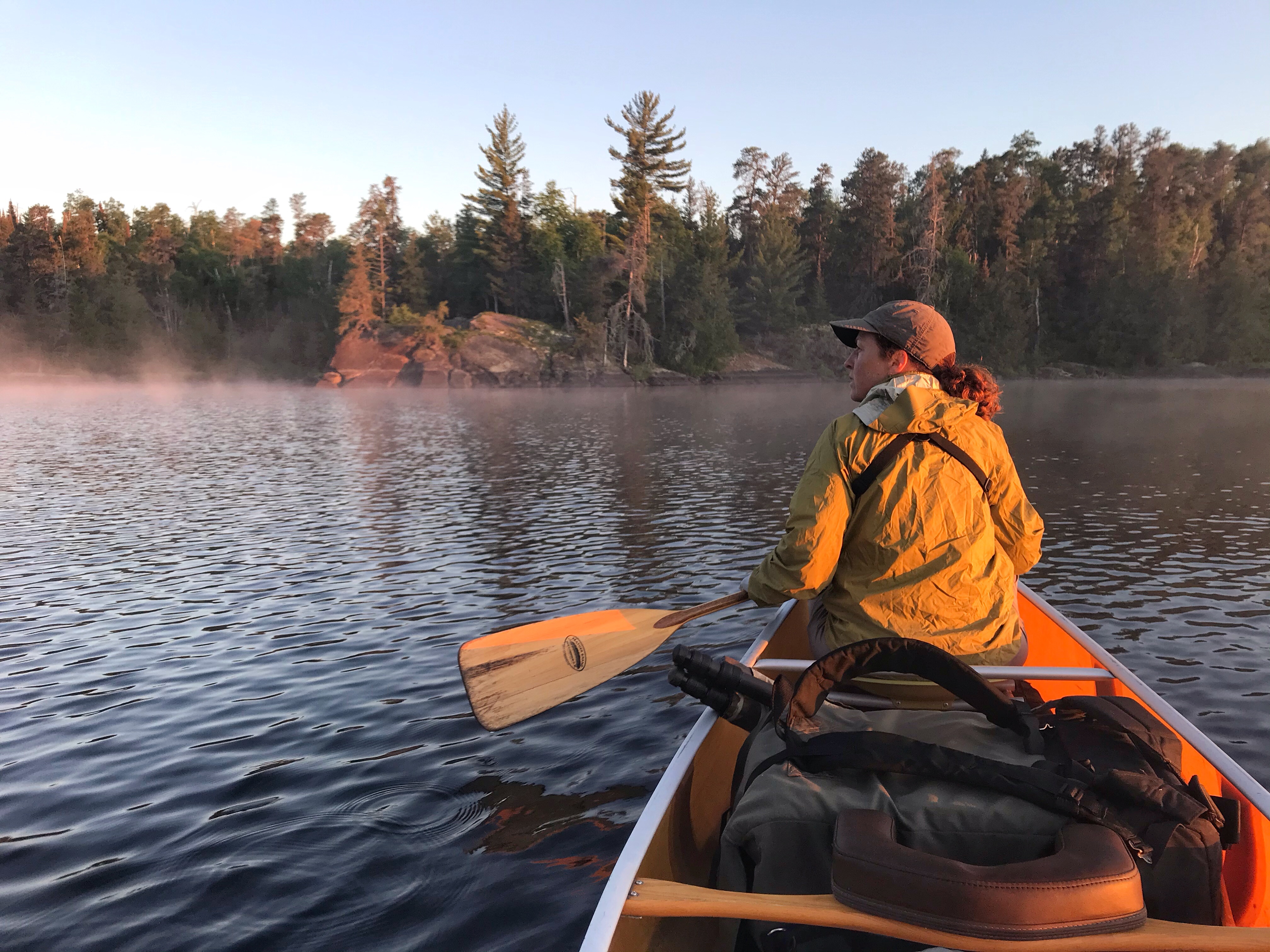
We have also, as loyal readers of this blog know, taken a serious interest in backpacking since then. So, Plan B was to join our Durango friends (Rob & Amy, Dave & Carol) on Vancouver Island and tackle the gnarly West Coast Trail and then hopscotch our way back slowly across the county, backpacking shorter routes in British Columbia’s Sunshine Coast, Idaho’s Sawtooth Mountains and Wyoming’s Wind River Range. Great plan…until Covid hit the planet and disrupted everyone’s plans! Canada remains essentially closed to foreign travelers (I can’t blame them) and the thought of traveling far from home, at least during the planning phase, seemed risky.
So, we thought, where can we go that’s within a day’s drive or so from Chicago, provides some serious outdoor adventure, but also some much-needed wilderness solitude? The answer quickly became northern Minnesota, home of the Boundary Waters Canoe Area Wilderness (BWCAW) and the Superior Hiking Trail.
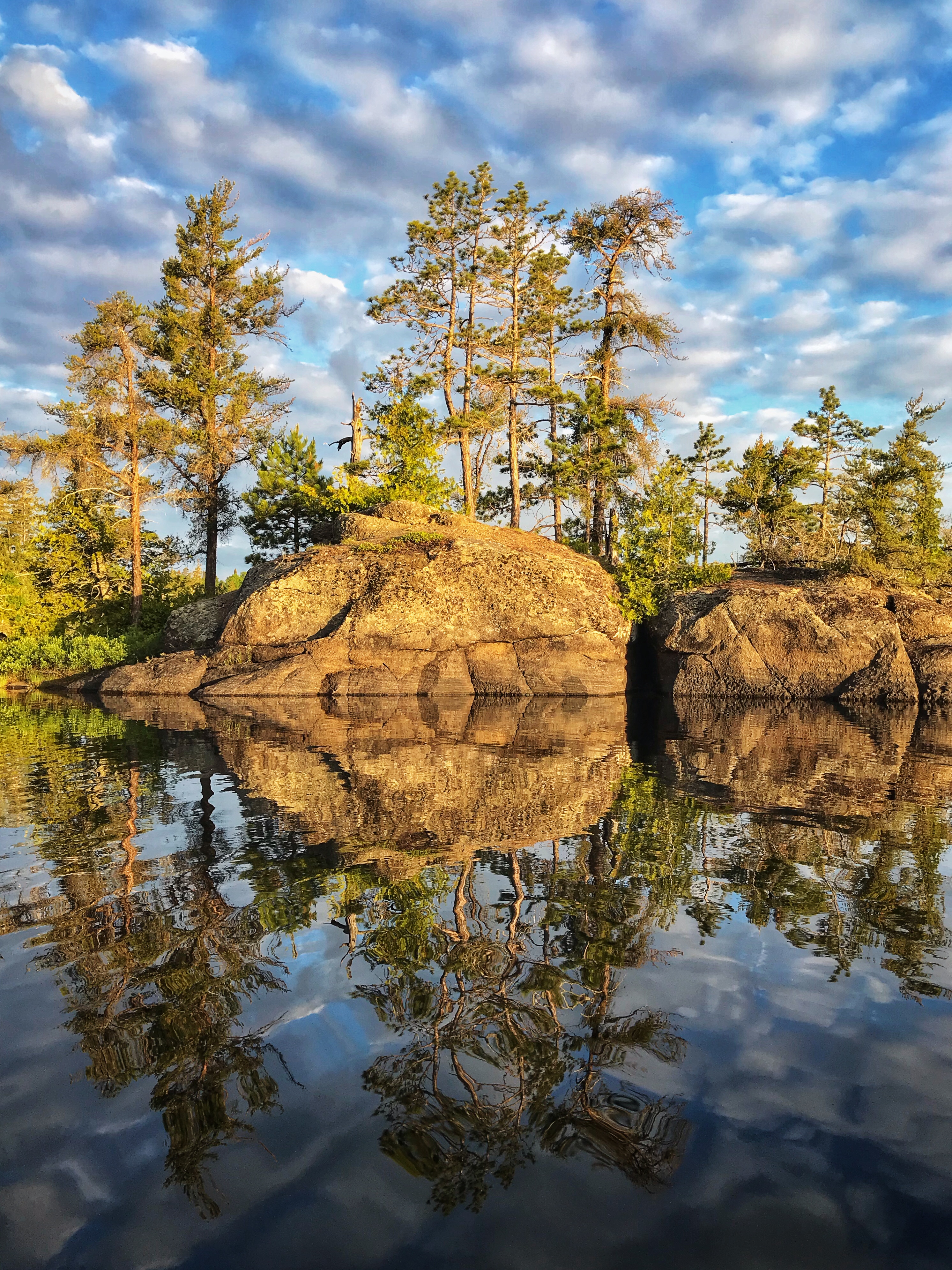
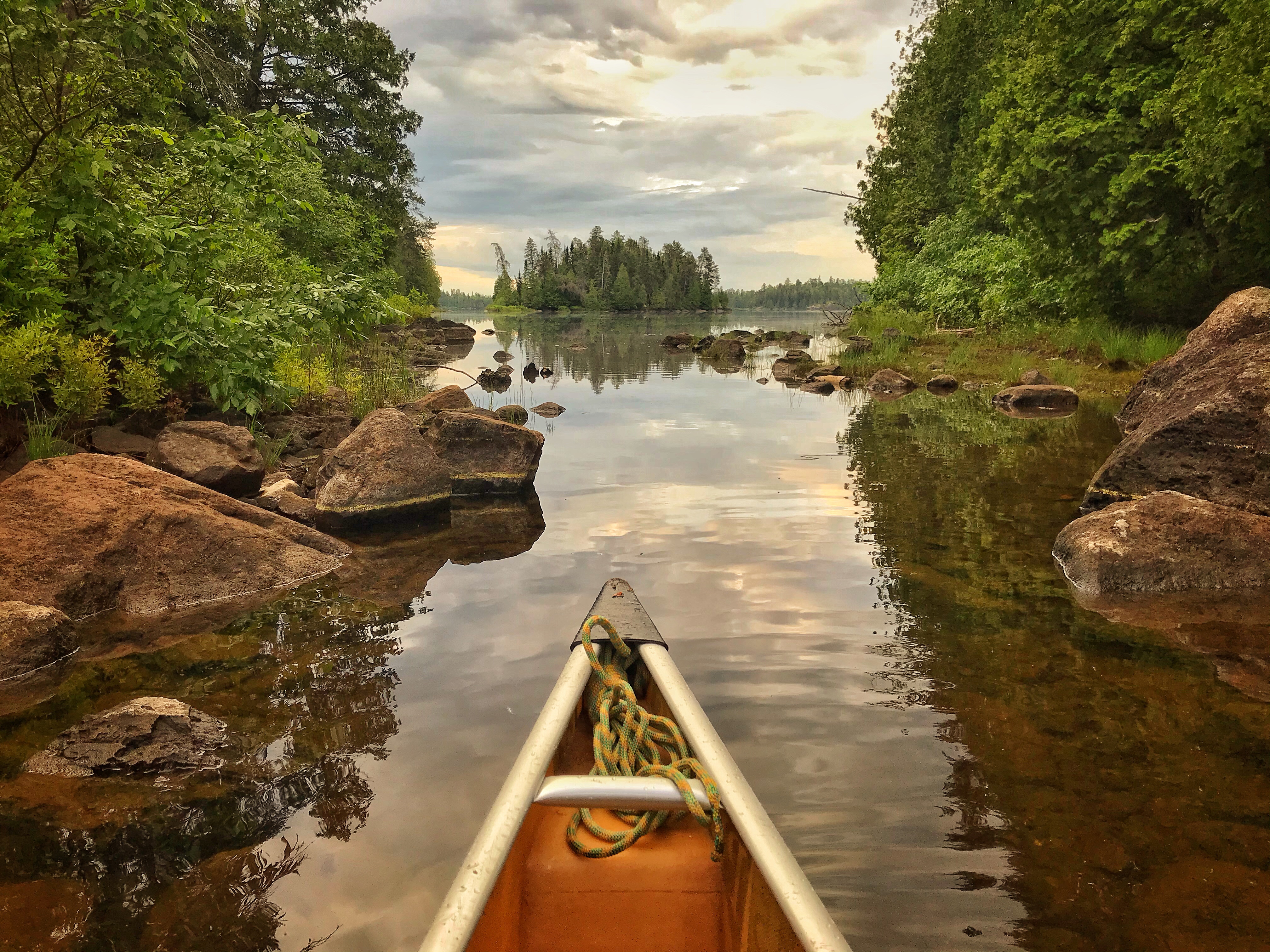
In addition, our good friends from Duluth offered us the use of their newly refurbished, but rustic carriage house, so we had a cool place to stay and visit and still remain socially distant (I’m as tired of that phrase as I am of Zoom, like so many of you).
Grateful for a viable Plan C, we hit the road and left the metropolis behind for a place where masks are not needed at all times and where the Internet doesn’t work. Our new plan is to spend 9 days canoe camping in the Boundary Waters and then backpack the 300-mile Superior Hiking Trail, thru-hiking from the Wisconsin/Minnesota border up the Arrowhead along Lake Superior to the border with Canada. Combined, these two activities should give us a maximum of time to commune with nature and a minimum of close contact with our fellow human beings.
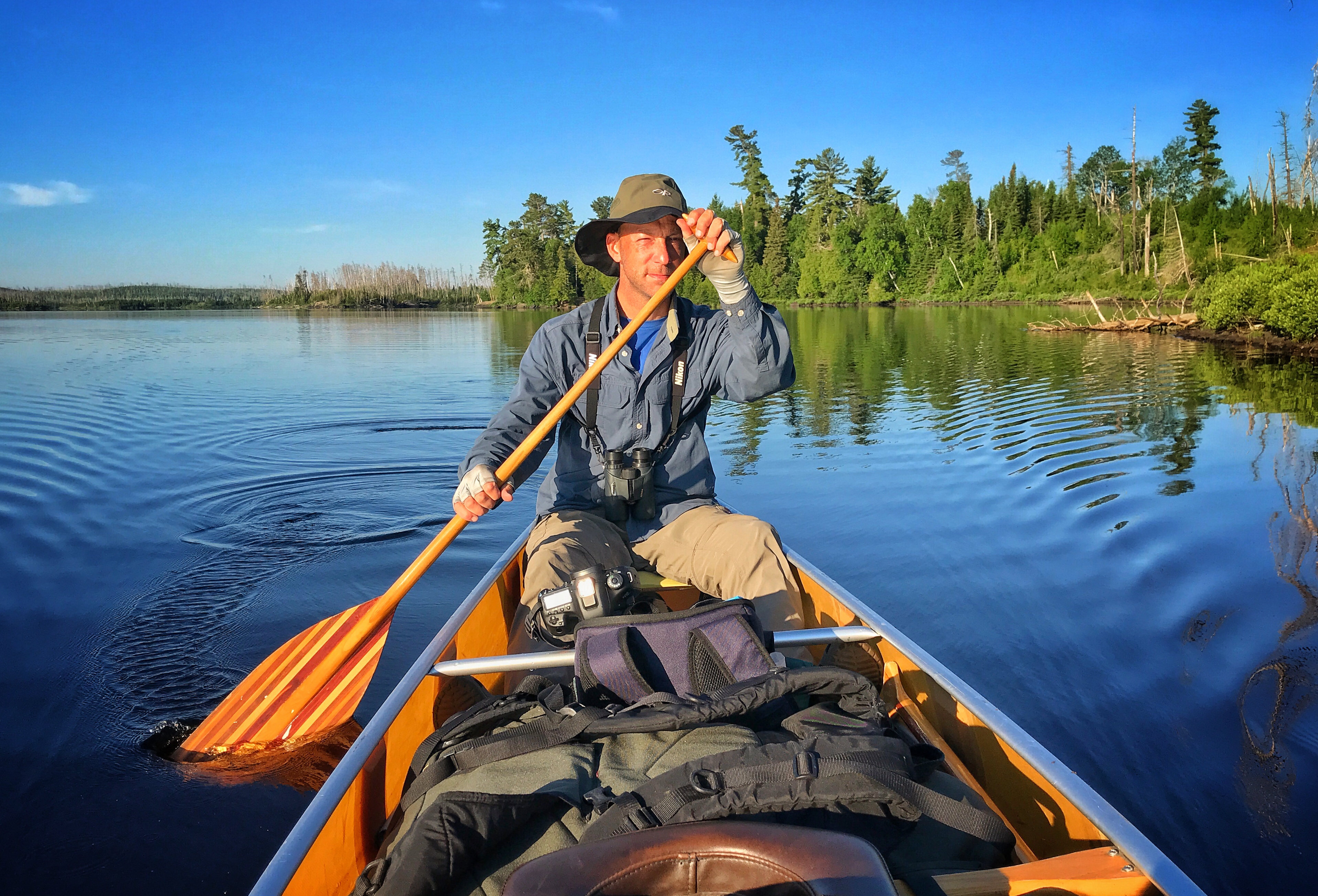
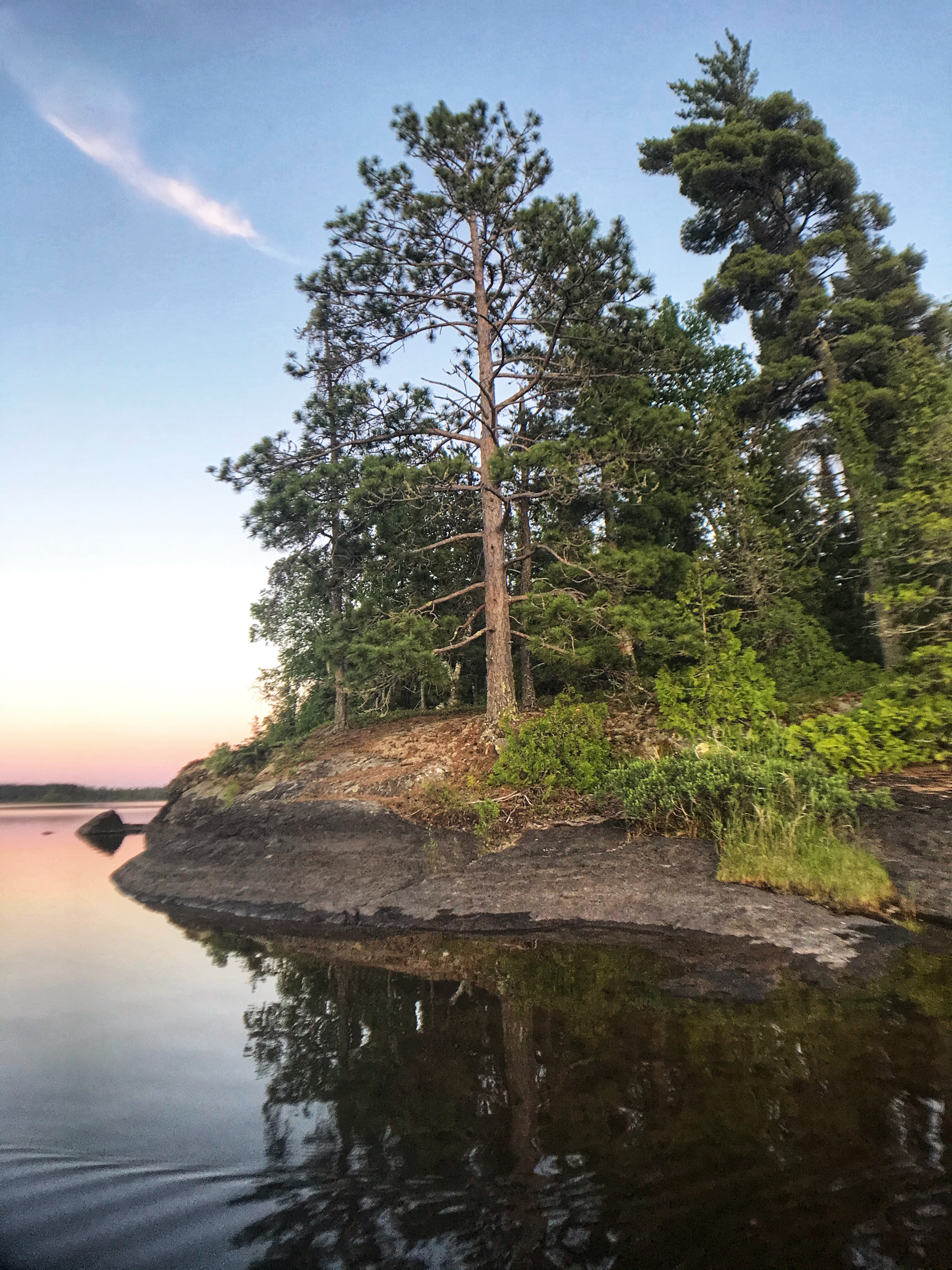

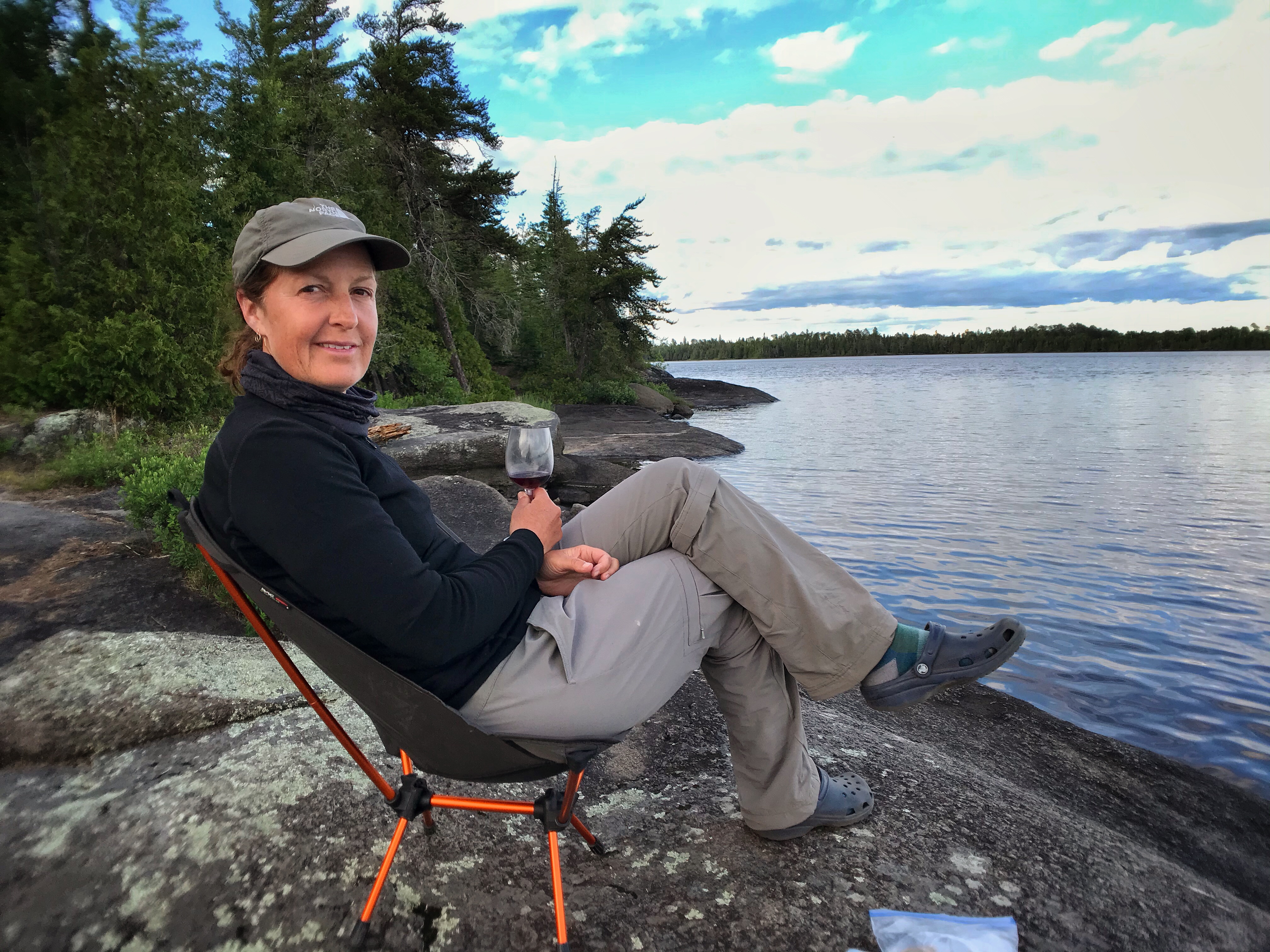

As I write I am sitting on the “front porch” of an island campsite on Lake Insula, on a calm late afternoon, listening to the chatter of a red squirrel and the occasional cry of an eagle as a female merganser with 20 chicks suddenly paddles past.

We have been out since 5 am on a day cruising for wildlife to photograph. My arms are tired from paddling, but we jump right back in the canoe to follow the merganser family and see if we can’t get a better look at this exciting Boundary Waters “Moment of Nature.”
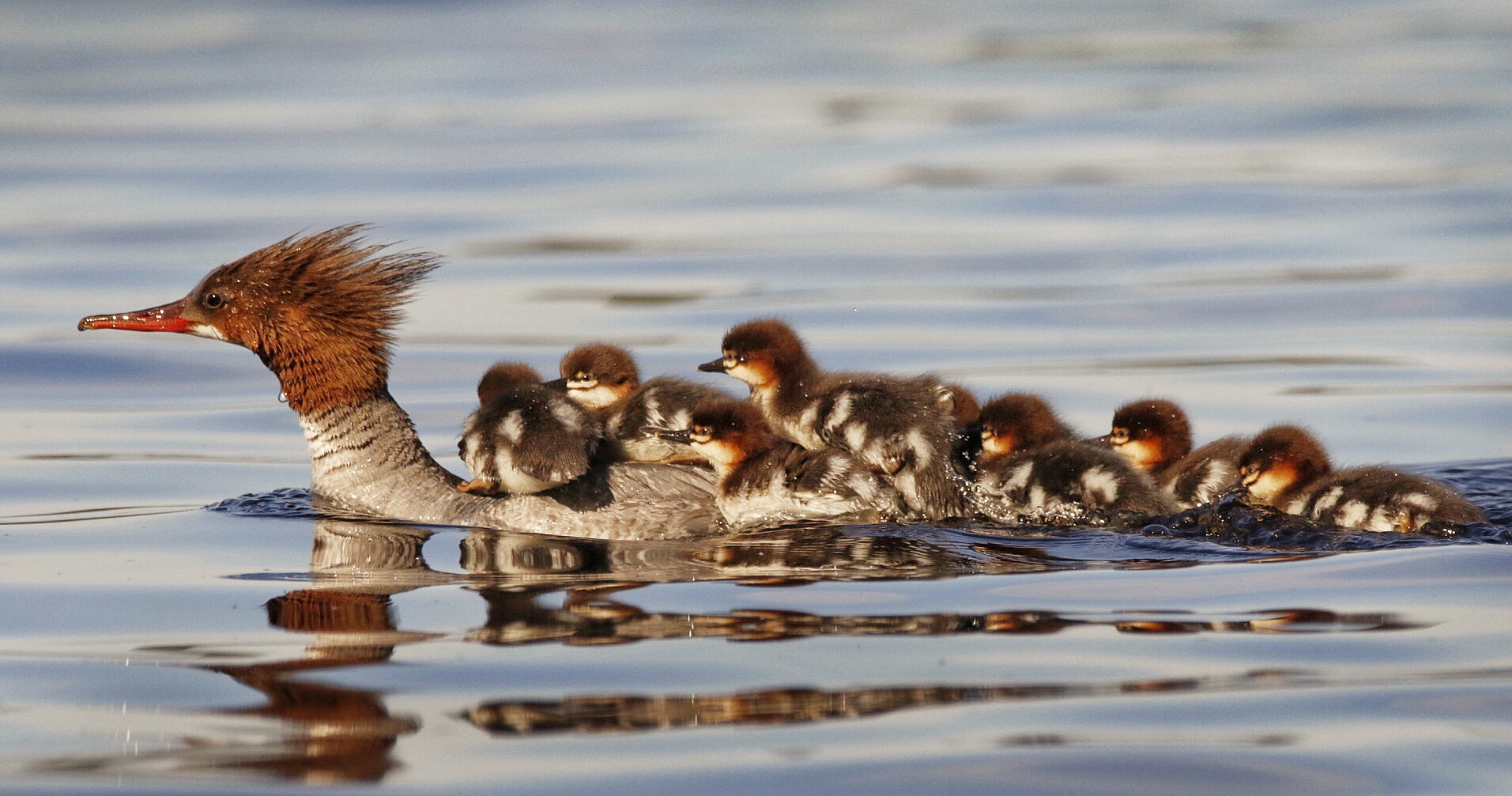
This has been the focus of this trip: to slow down, observe, explore, learn about and photograph the flora and fauna of canoe country. We have been here at least 15 times previously but all for different reasons. We have guided middle school children on 5-day wilderness excursions for the PaddleQuest organization, traveled multiple times with friends and toured lake country many times on our own, but the focus before has always been more on the route, the portages and the sights seen quickly along the way rather than on taking time to really appreciate a few places well.
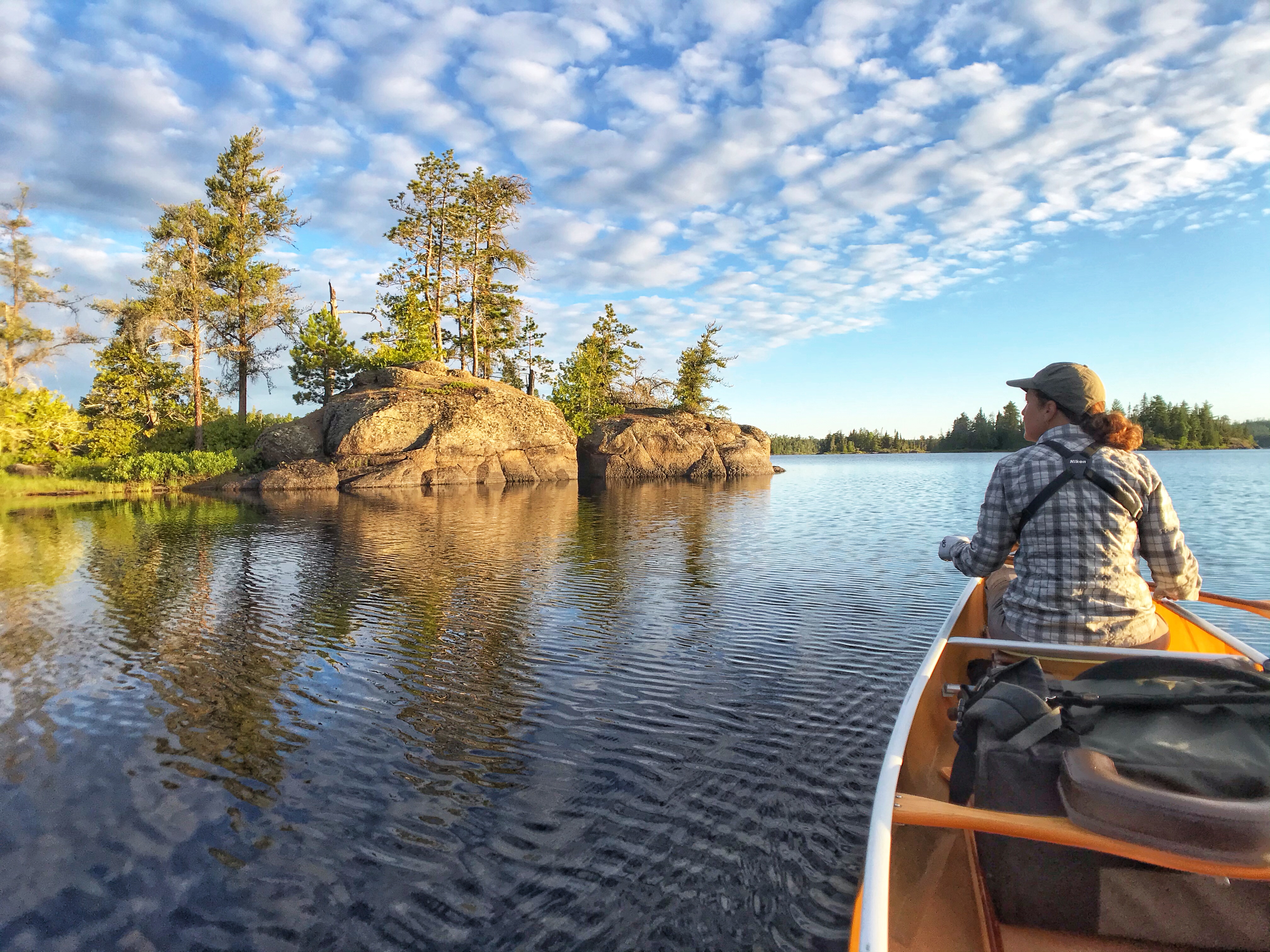
So, after a wonderful weekend warmup on Slim Lake with our Duluth friends and their two children, now age 8 & 10, we turned right back around and headed in via the Lake One Entry. We stayed two nights on a site on Lake Two that we’ve been to before, then hoofed it all the way to the north side of Insula. We were fortunate to find one of the premier island sites available (in fact, a site I stayed on 17 years ago on my first PaddleQuest trip) and here we have based for the last 3 days.


Sigurd Olson, prophet and arguably savior of this unique wilderness paradise, says in his collection of essays Reflections from the North Country that we humans need wilderness, seek out its solitude for the replenishment of our souls, and rediscover harmony with nature. “The most important function of the wilderness for modern man is the opportunity of glimpsing for a moment what harmony really means.”

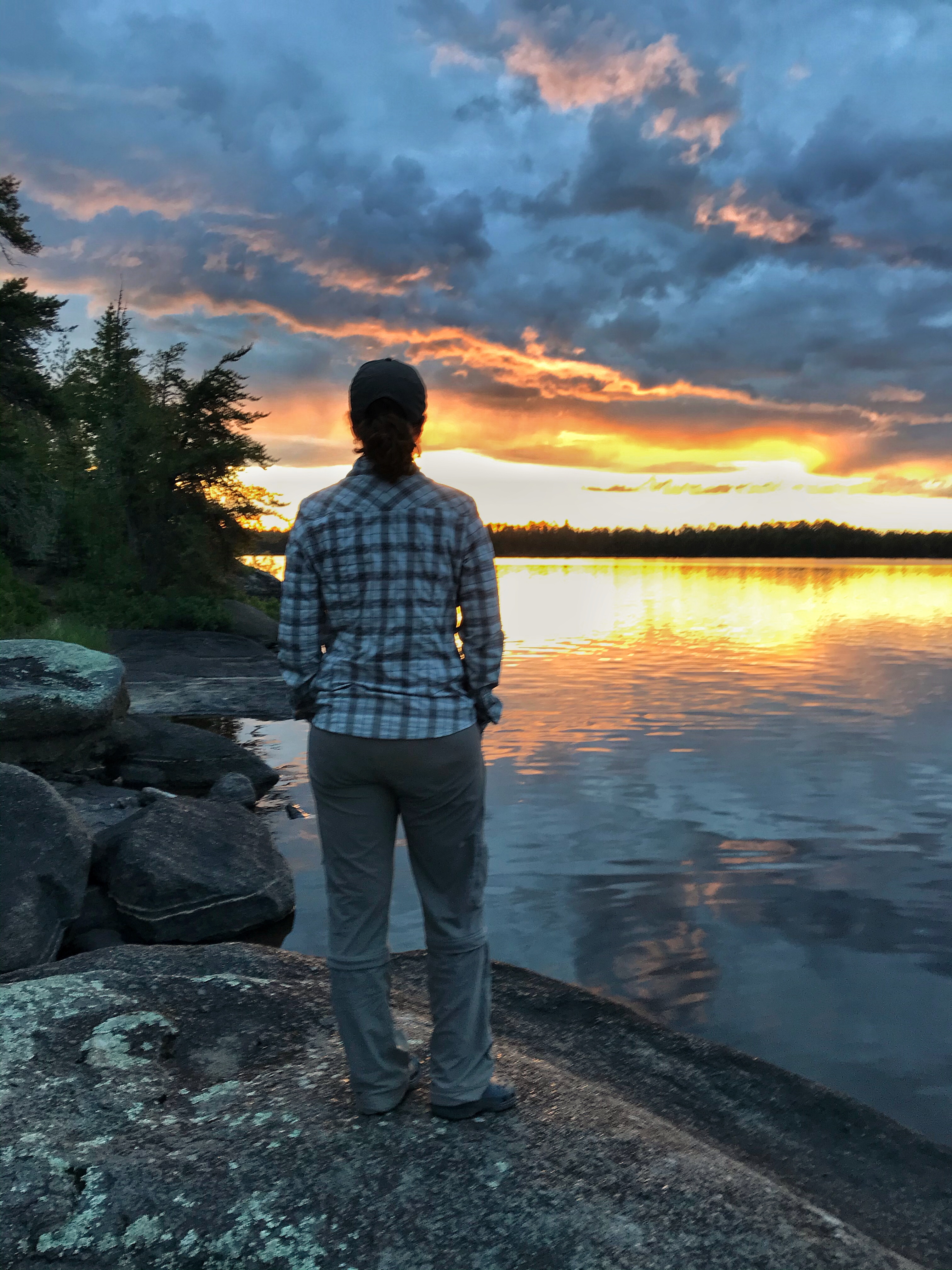
This has never been more true or more needed, on a personal level, than after three months of shelter-in-place style quarantine in a big city like Chicago. The return to simplicity and to a place where nature is unspoiled feels safe and comforting at a time when so much else is so uncertain and changing every day. To borrow from Oliver Wendell Holmes, we are in search for “the simplicity on the other side of complexity.”
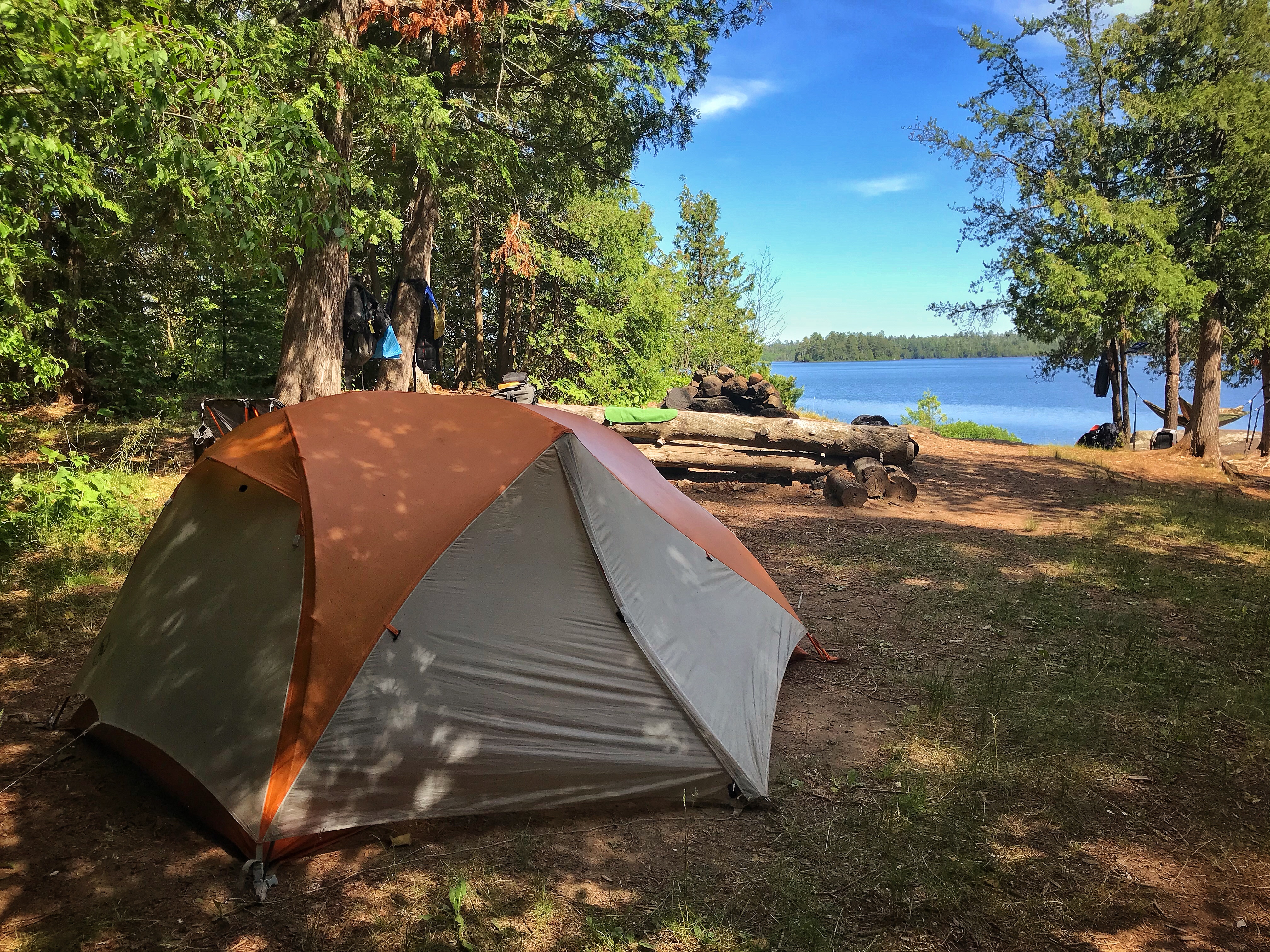
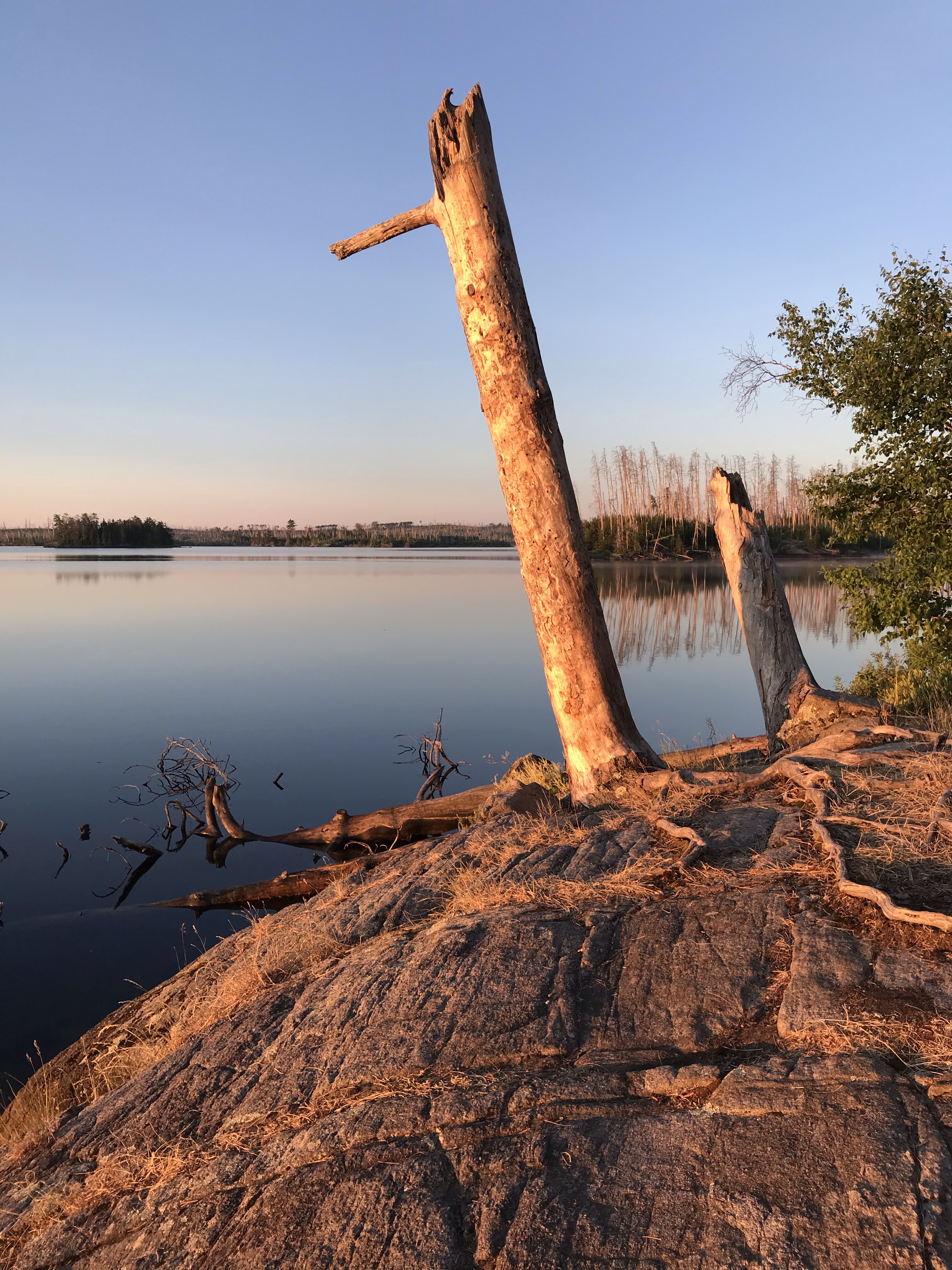
Out here in the great Quetico-Superior region, time follows ancient patterns. It’s June, so the warblers have arrived after their long migration, the mayflies and dragonflies have hatched, the fish are jumping, the eagles are soaring and the mergansers are shepherding their flotilla of chicks around, teaching them how to fish and trying to keep them safe.

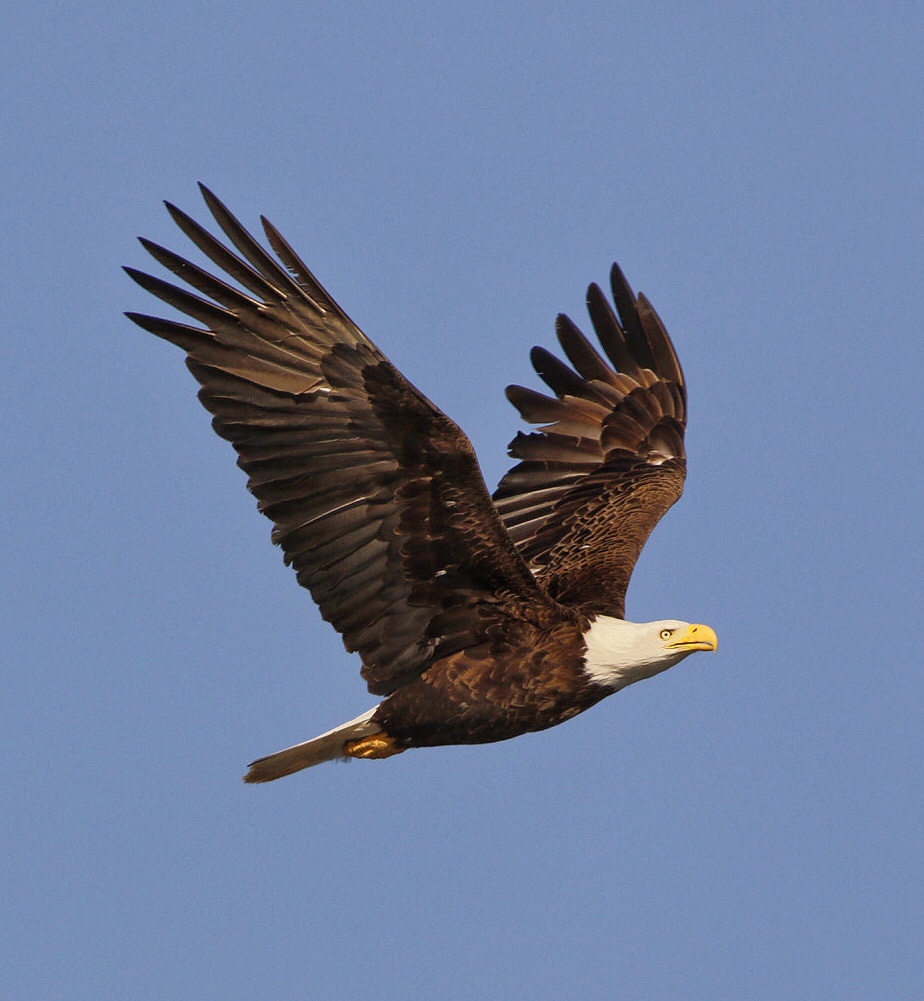

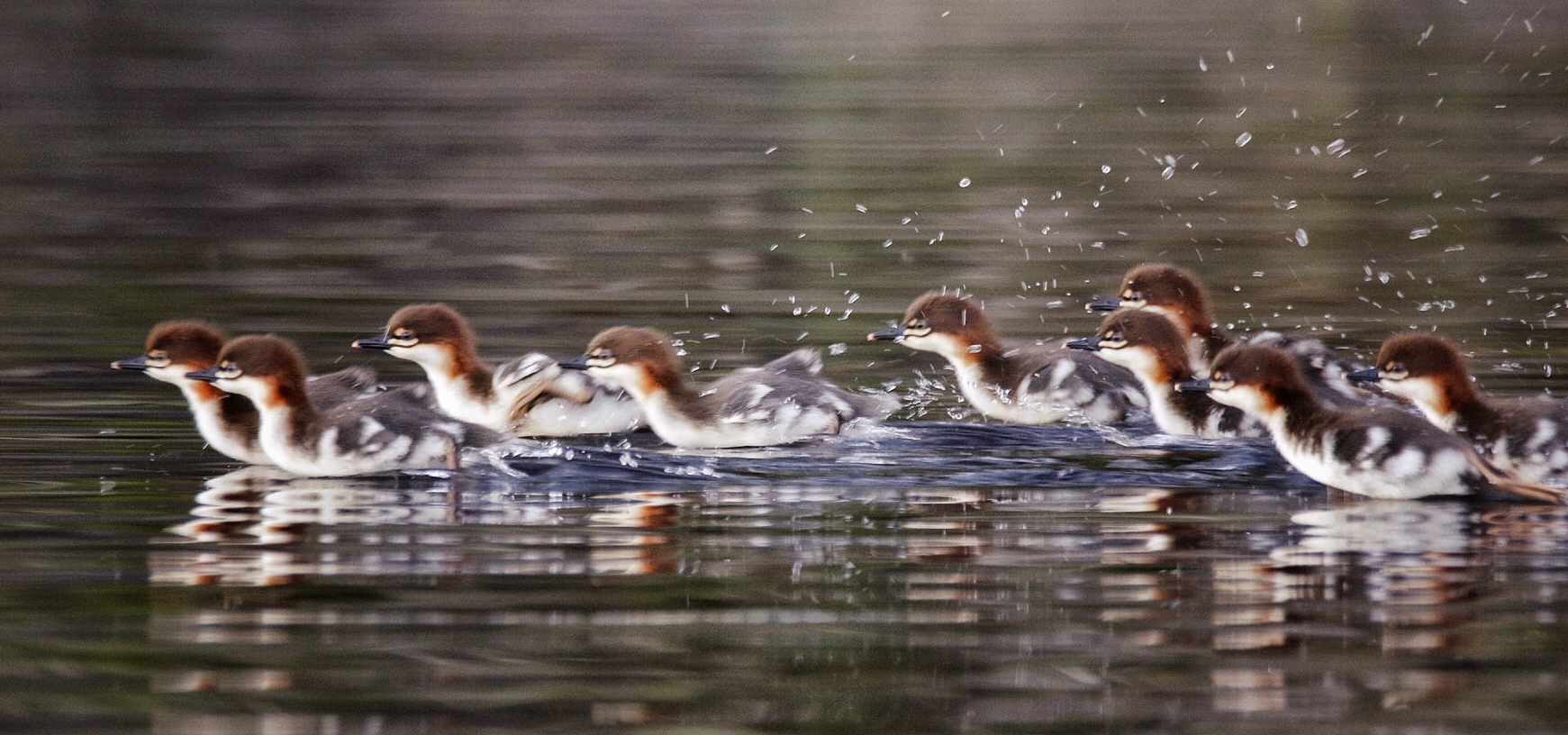
Any day now the loons will do the same. Our hope is to catch a few loon chicks riding atop the backs of their parents before we leave. Now is the predictable time, the 4th week of June, that this annual event should occur. So far no luck, but that’s not for a lack of trying.
What a week its been! We have, each day, arisen early to see the sun rise and get out on the water while it’s still as glass and every one else is asleep, except of course, the animals. We’ve gone for long (like 9-10 hour long) paddles, slowly exploring the shore line and back bays of each of the lakes we’ve stayed on, hoping for certain subjects, but open to wherever the day takes us.

Patience has been our ally and rewarded us with a great variety of scenes and subjects to observe. A few have been memorable, so we’ll share a few nature stories of our own. There is so much more going on all around us when we stop to smell the roses.
The reward for going slow is that we see more variety and observe more behavior than when we are moving with the primary purpose of padding x miles, portaging x times to get to the next site. We’ve rarely stayed on the same site two nights in a row, much less three, so this is definitely new territory, but the pay off has been great.
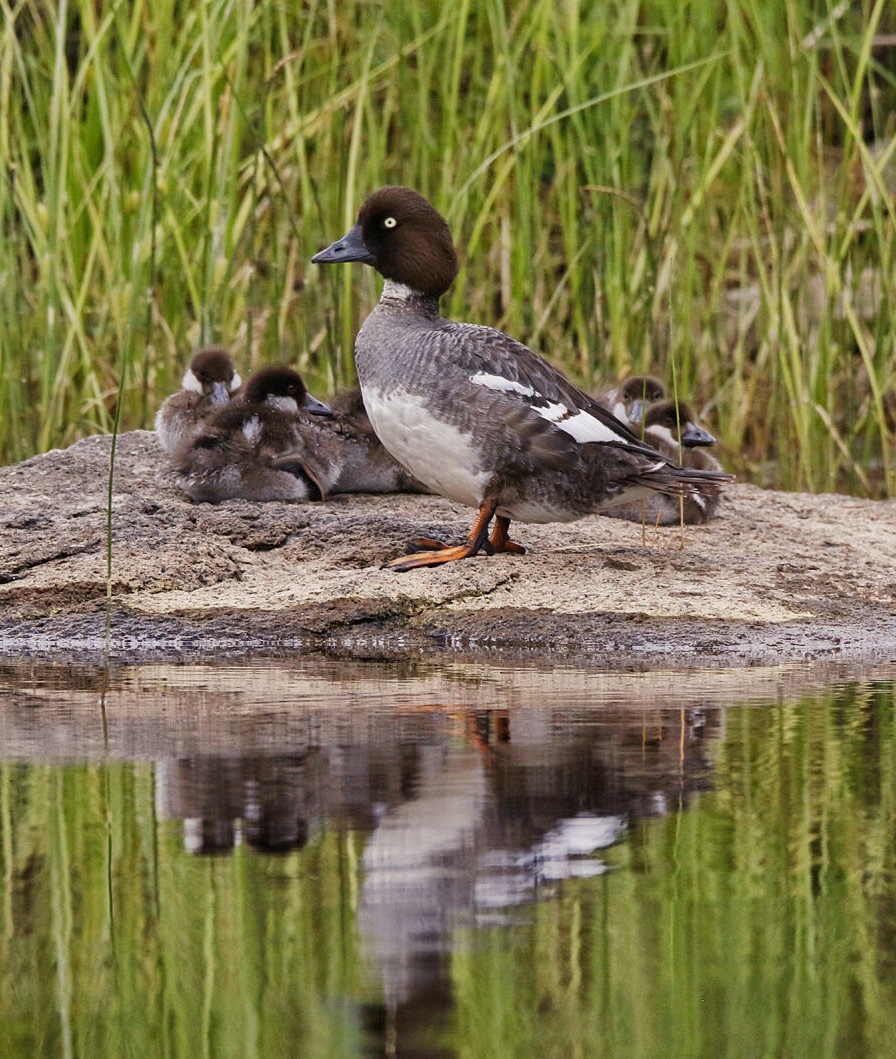
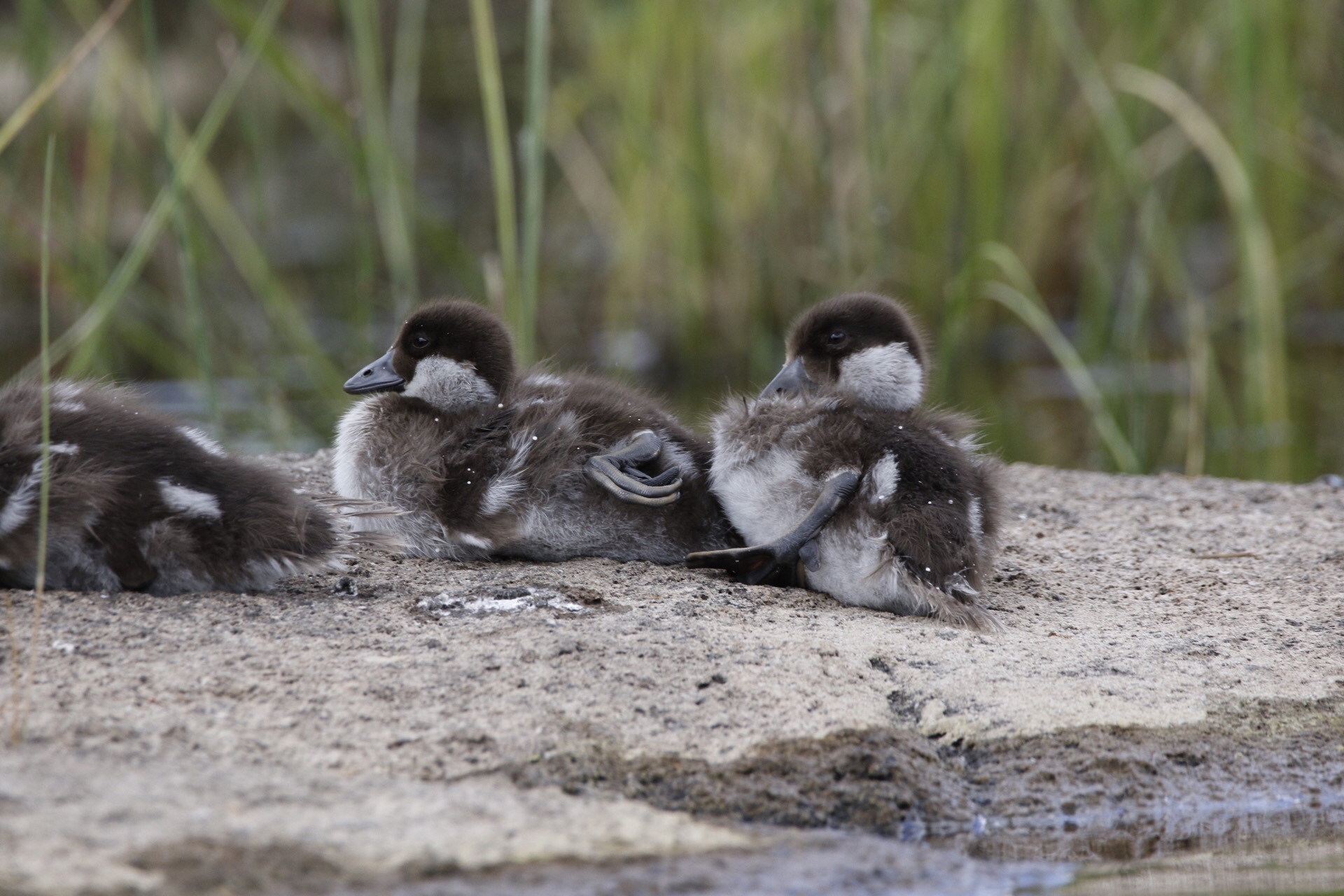
For example, the Common Merganser is one of the birds we see most frequently here. Typically we observe them sitting on a rock and, if we venture too close in our canoe, they hurriedly scurry off, quacking annoyedly at us as they swim away. With no pressure to get anywhere, we’ve seen the mergansers flying low as they practically skim the surface of the water and seen them in different lighting situations.
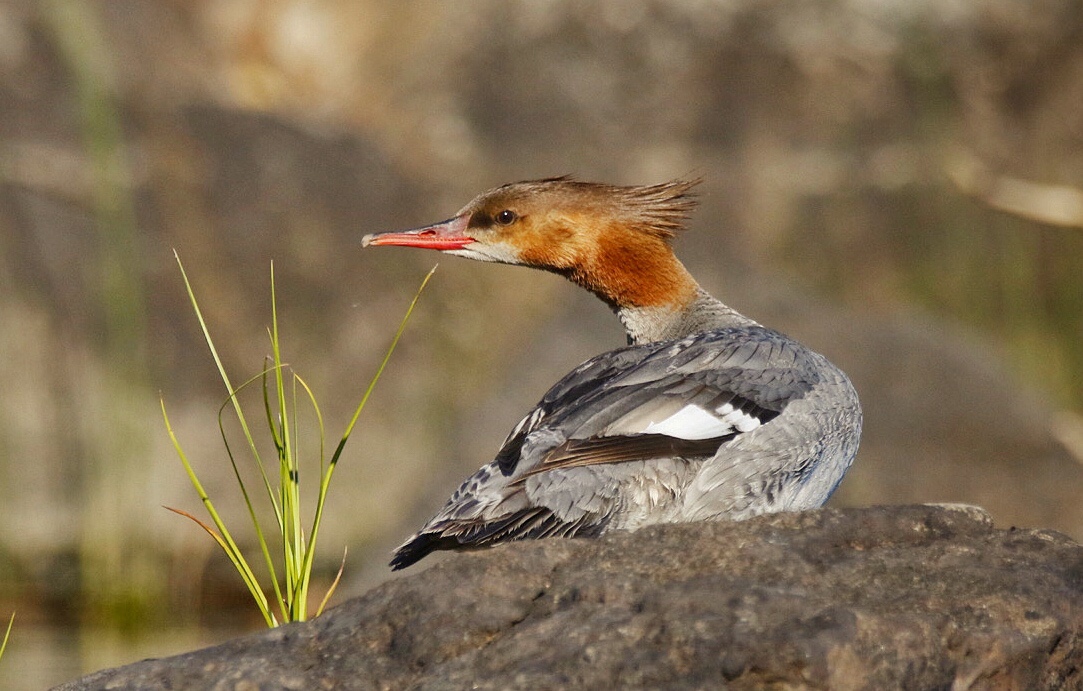
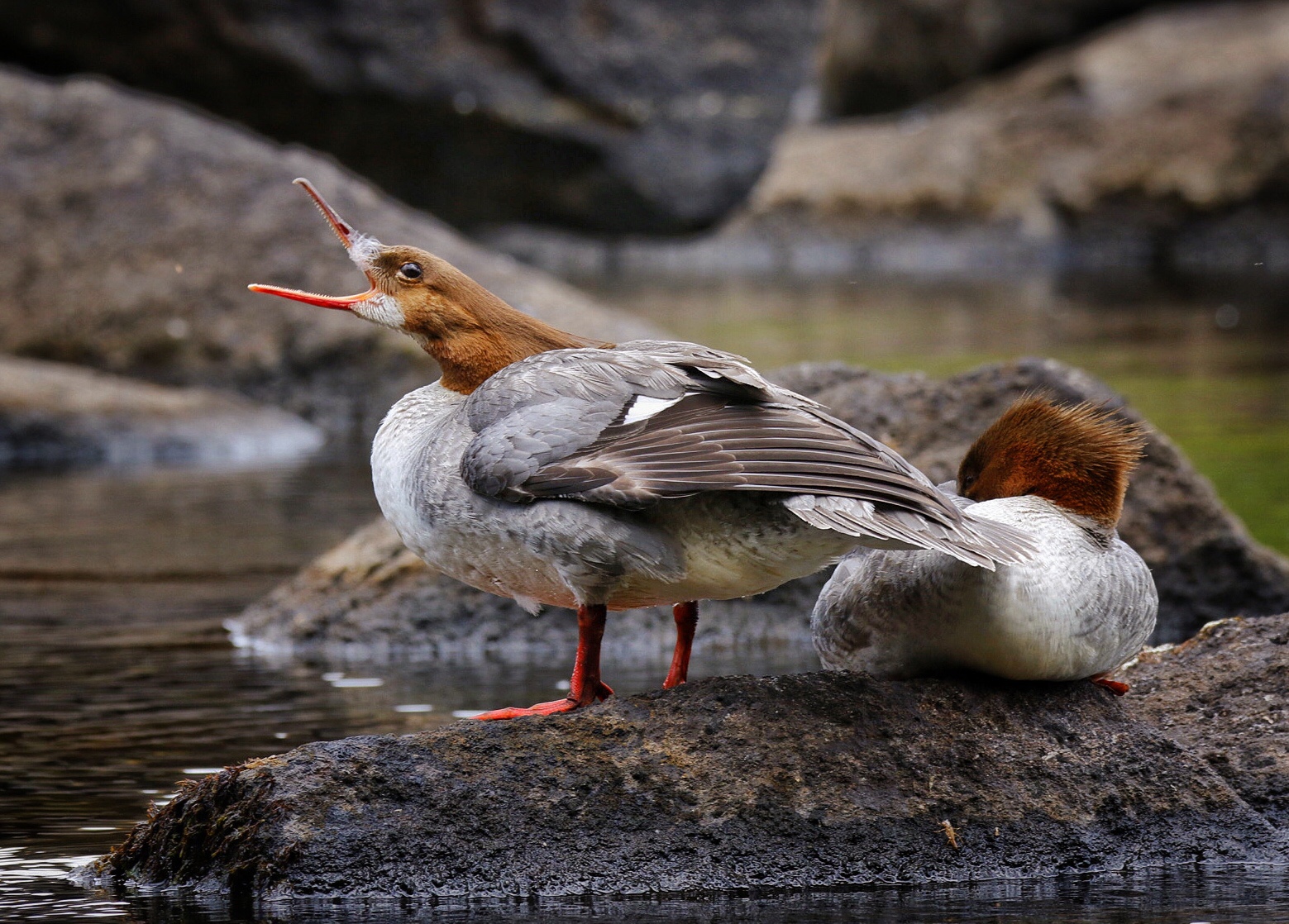
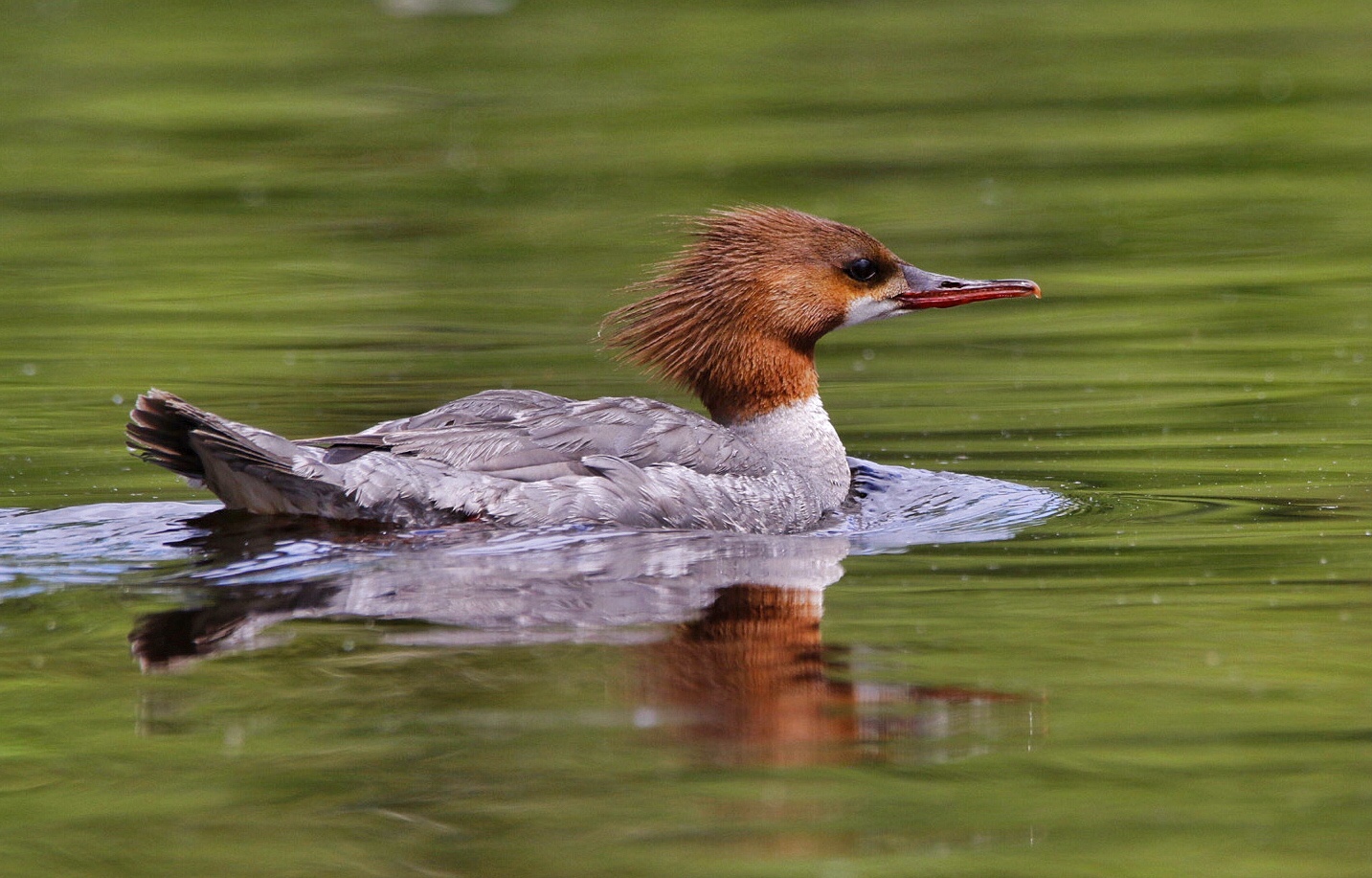

But we were especially amazed to see them on several occasions with their new chicks as the patient mother deals with a newly-hatched clutch of between 9-18 little ones!
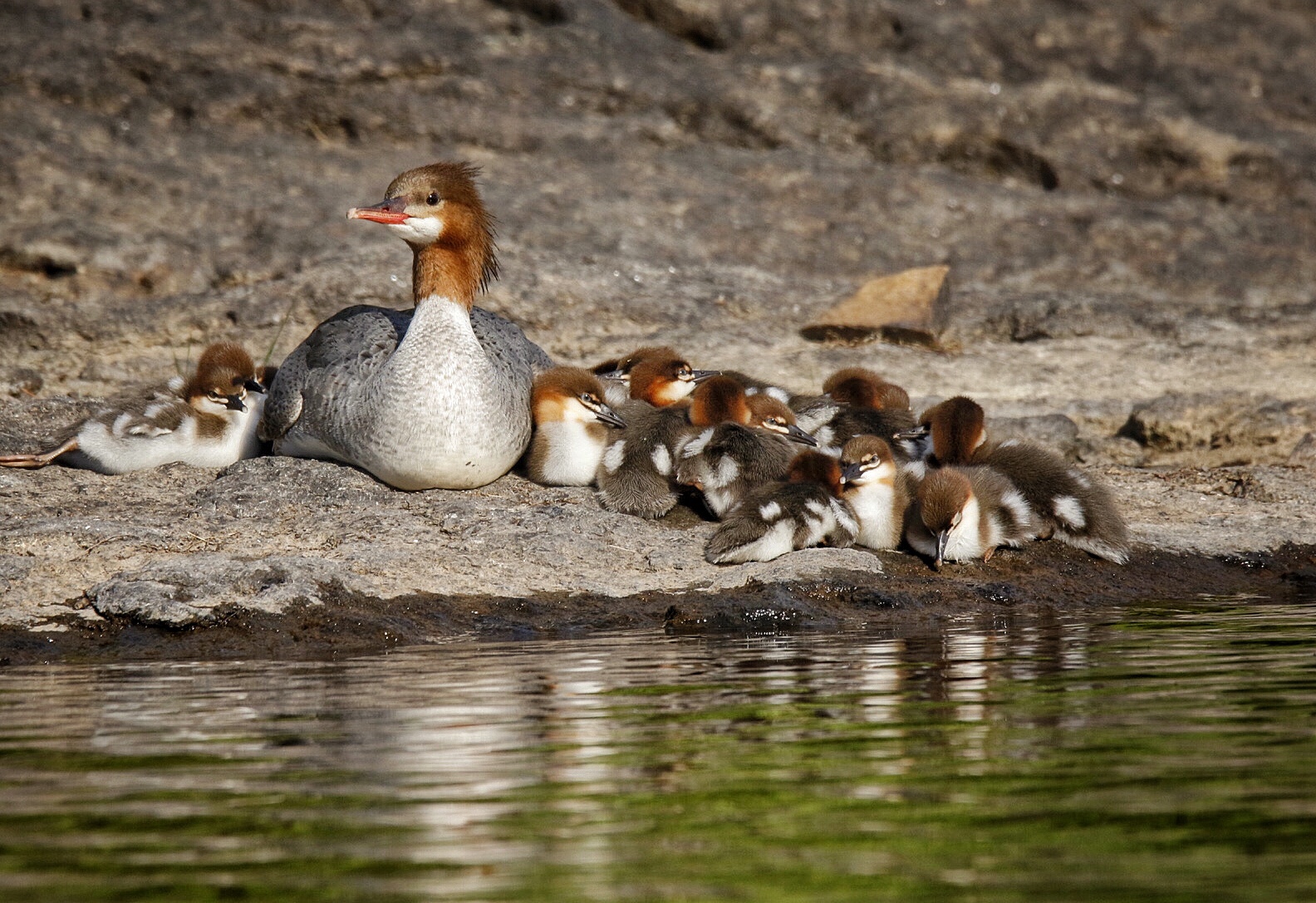
We took great joy watching them follow mom around, each taking their turn riding on her back. Occasionally, she would get annoyed by the pile on and, in a flurry of splashing, make a brief dive to shake them off her back, only to have this process start all over again.

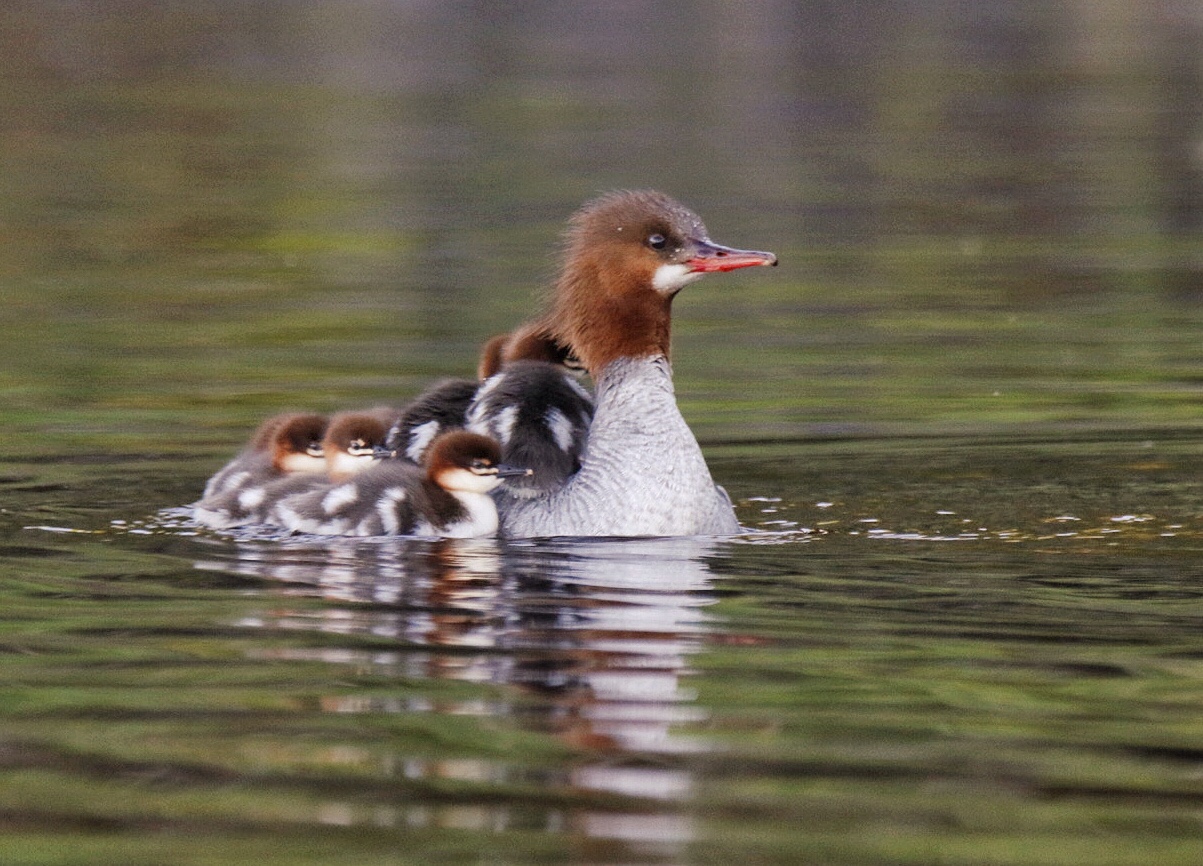

Undistracted, we had the privilege of witnessing wildlife in its natural habitat. The eagles are doing quite well in the Boundary Waters. We saw them perched majestically in white pines or near their enormous nests, soaring high above the lake in search of fish, occasionally being harrassed by other birds who were not happy with their predatory presence.
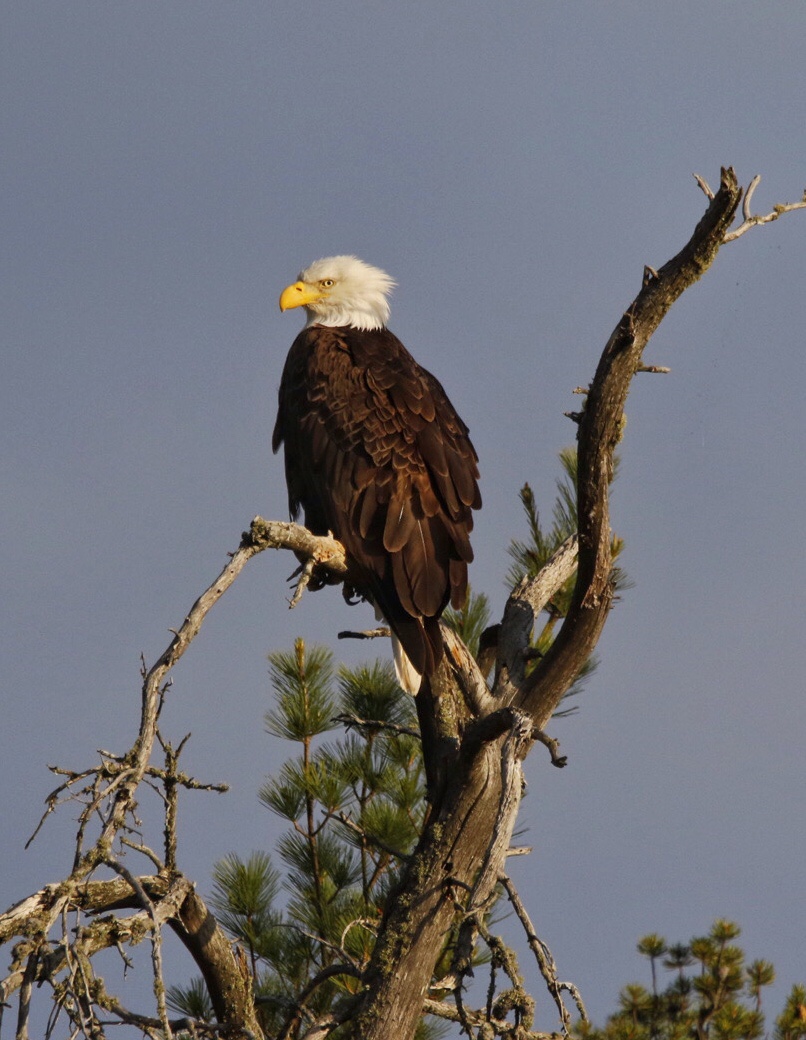
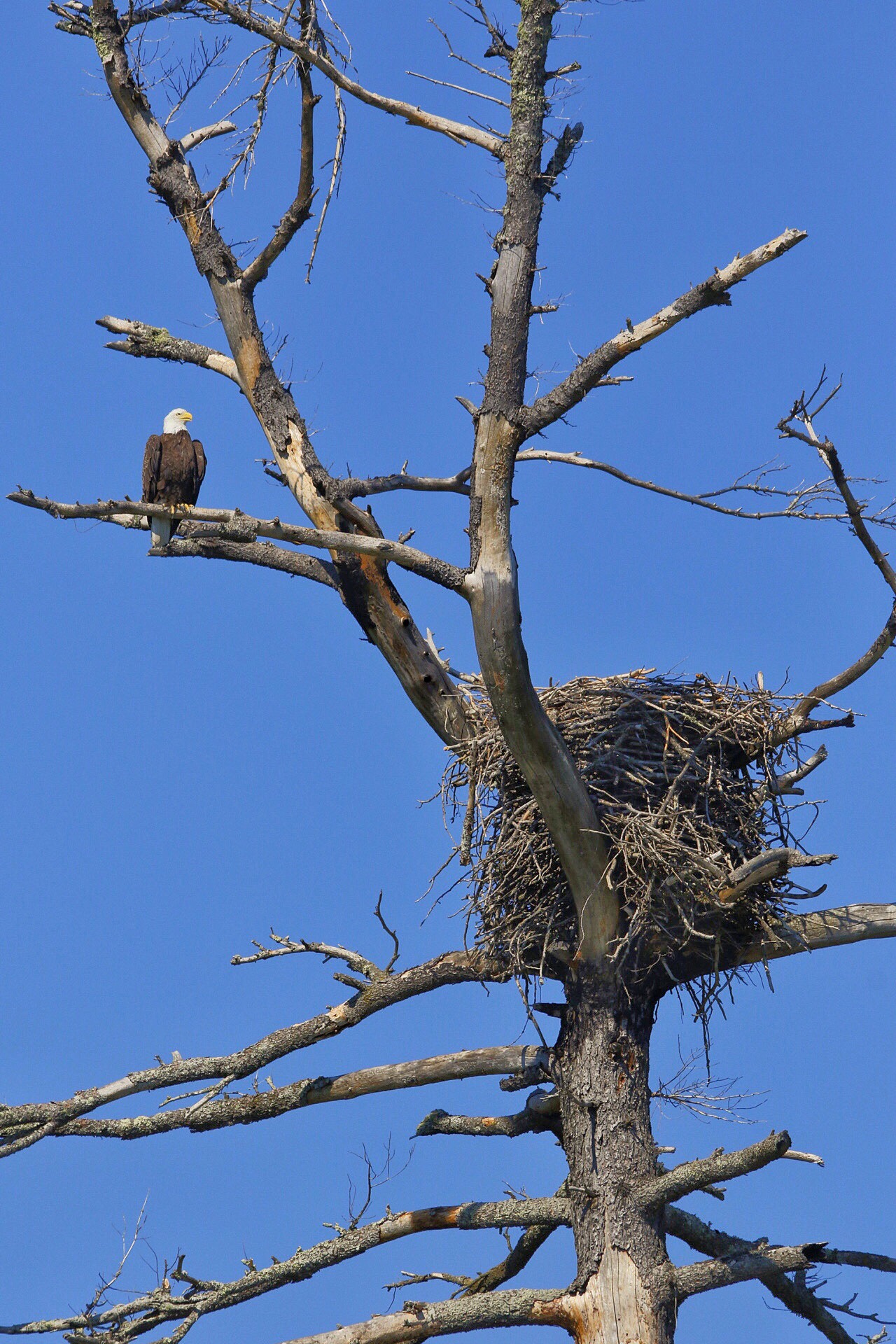
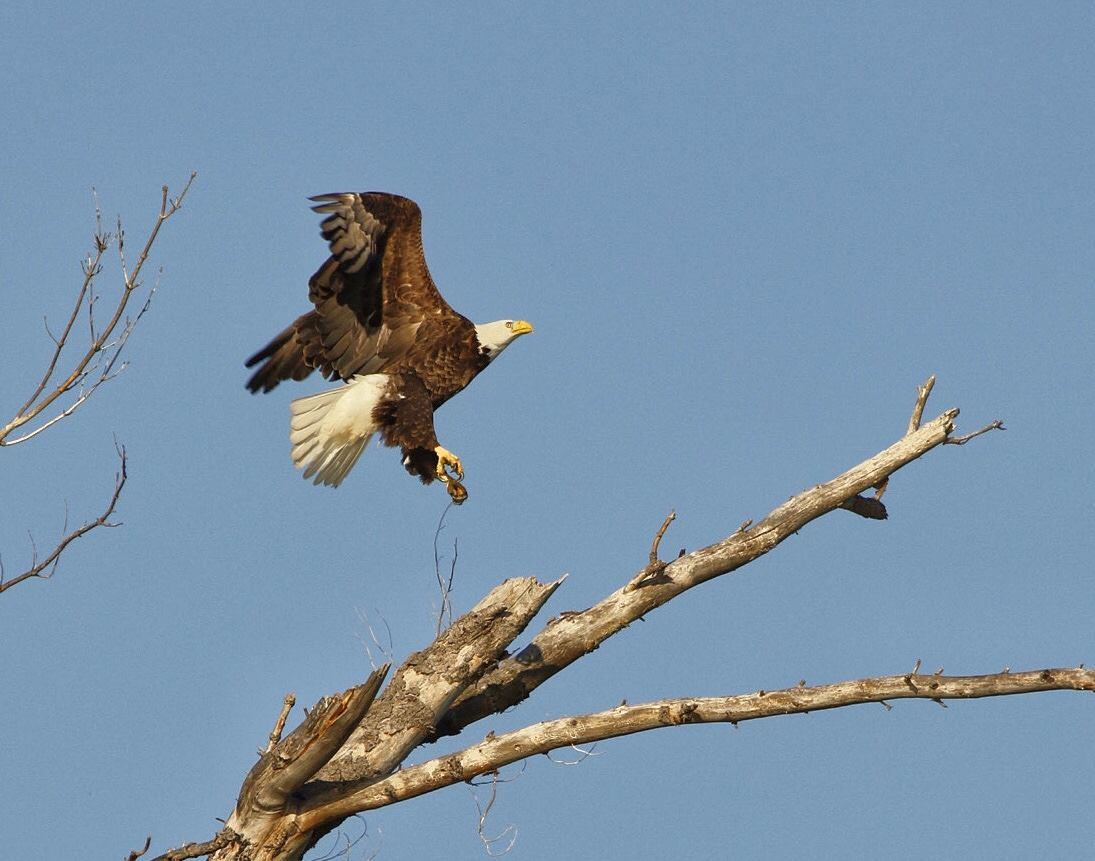

One day, we heard several loons making their warning cry and discovered three eagles flying and perching near by. One of them flew down to a downed tree near the shore and began jumping in the shallow water and bathing himself. We watched him do this for several minutes as he dove in and then shook the water off and began preening. He would have dried off in the sun if several grackles had not chased him off.
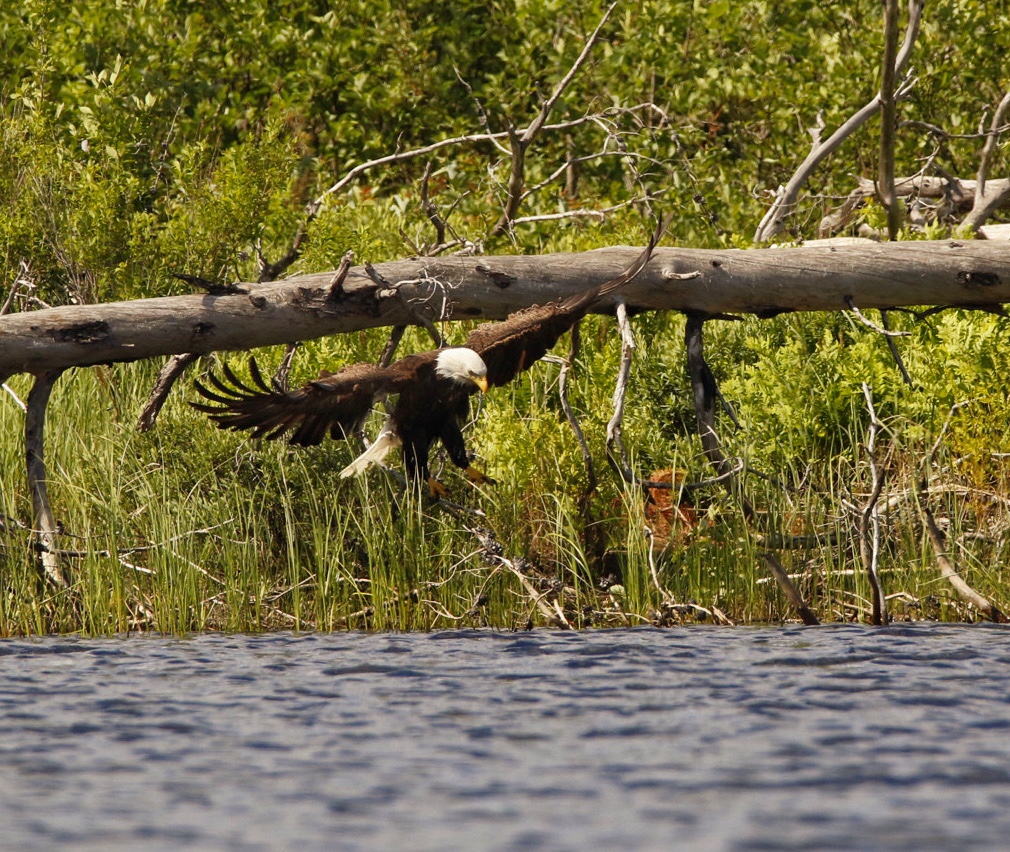
Being present to the moment and observant of beauty wherever we find it in nature allowed us to see and hear so much more on this trip than we ever have before. We saw beavers and otters swimming, a mute swan, a few Pileated woodpeckers briefly in flight, several species of warblers flitting about, Cedar waxwings in feeding flocks, and turtles sunning on warm rocks, including a huge snapping turtle that looked like he had been around since WWII!
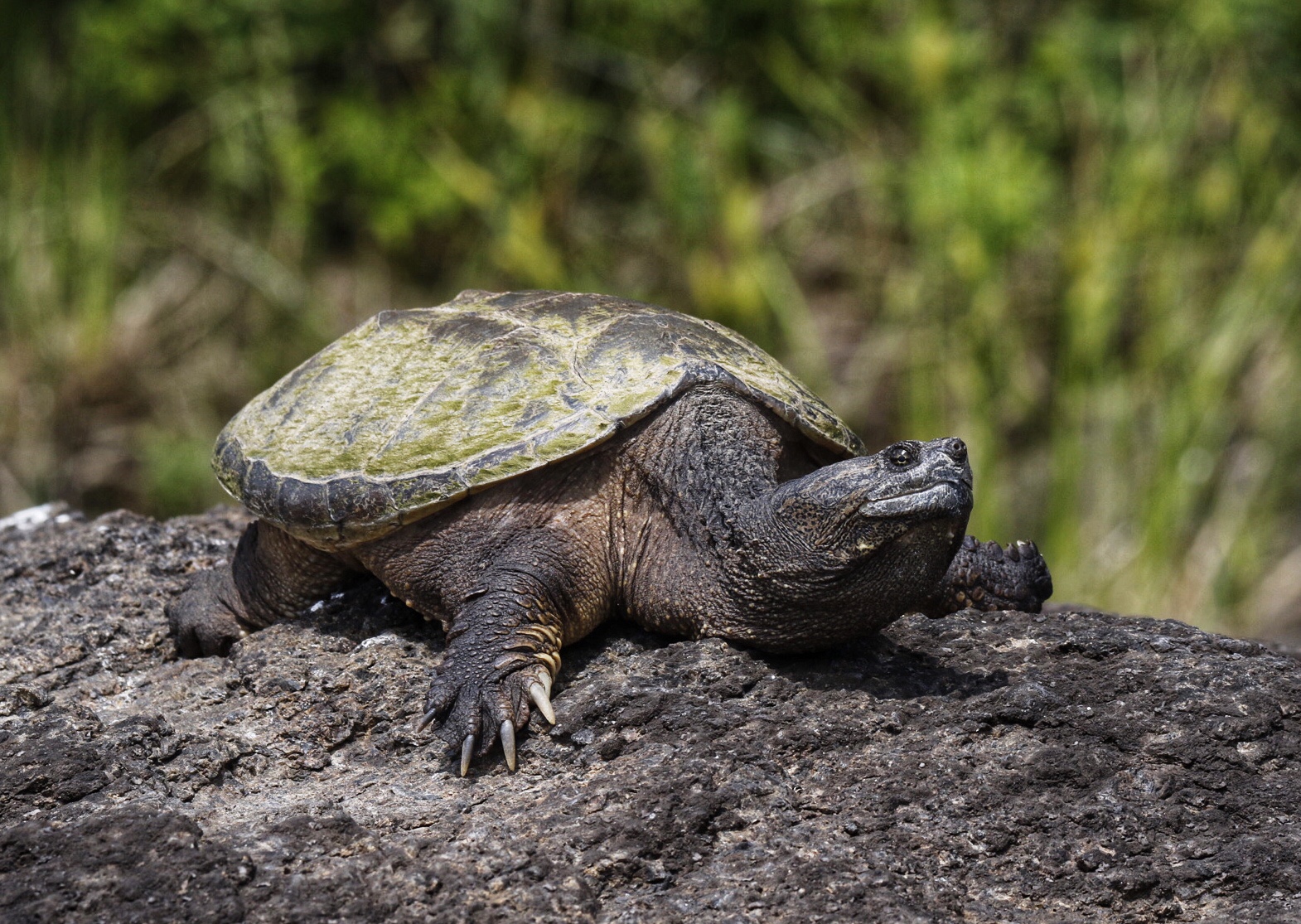
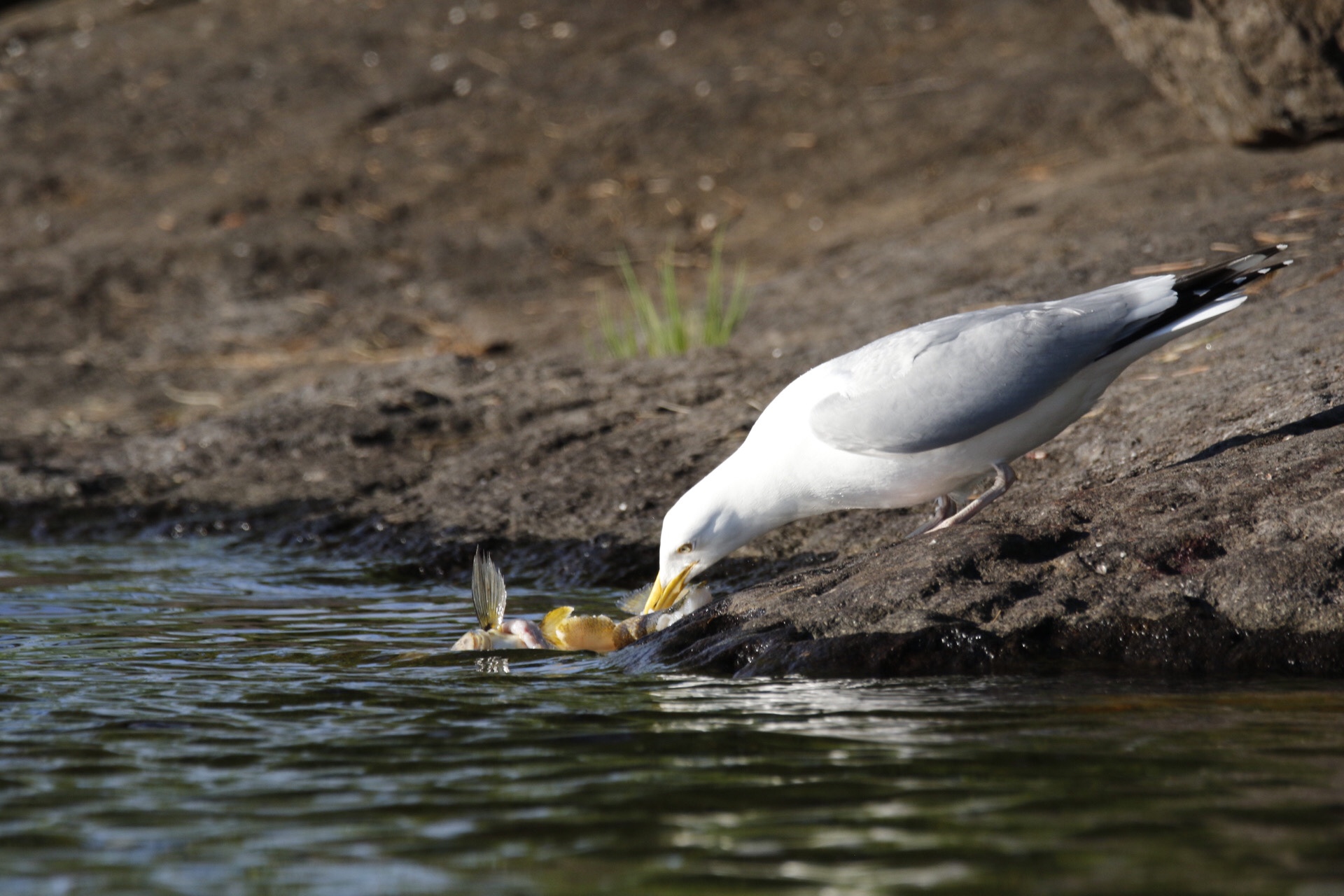
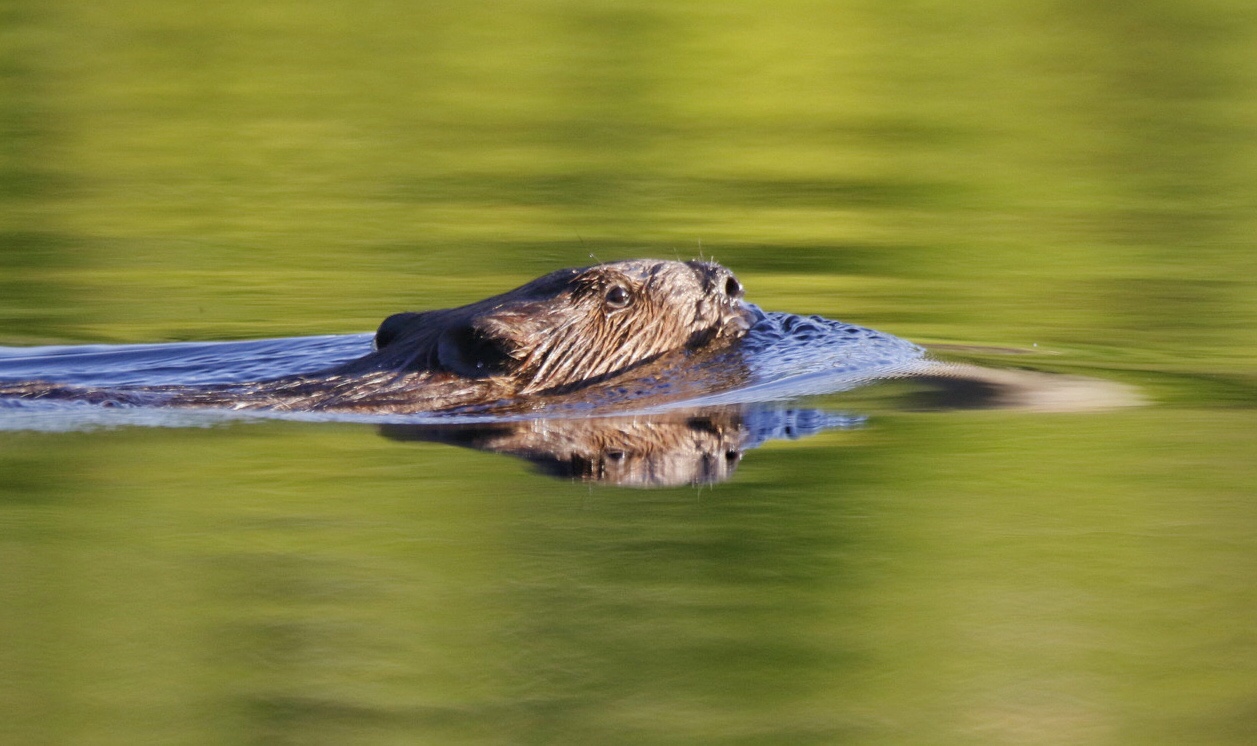
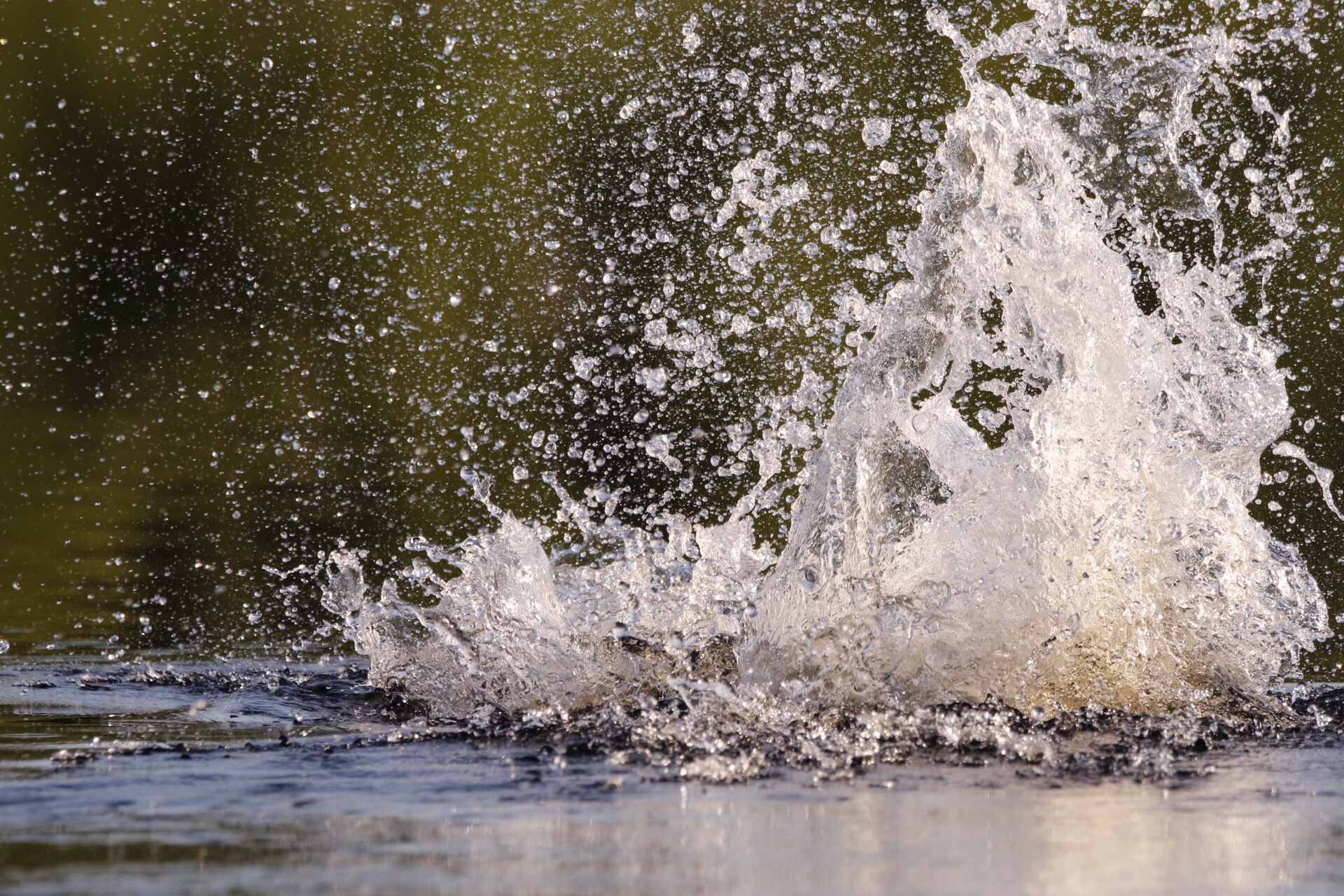

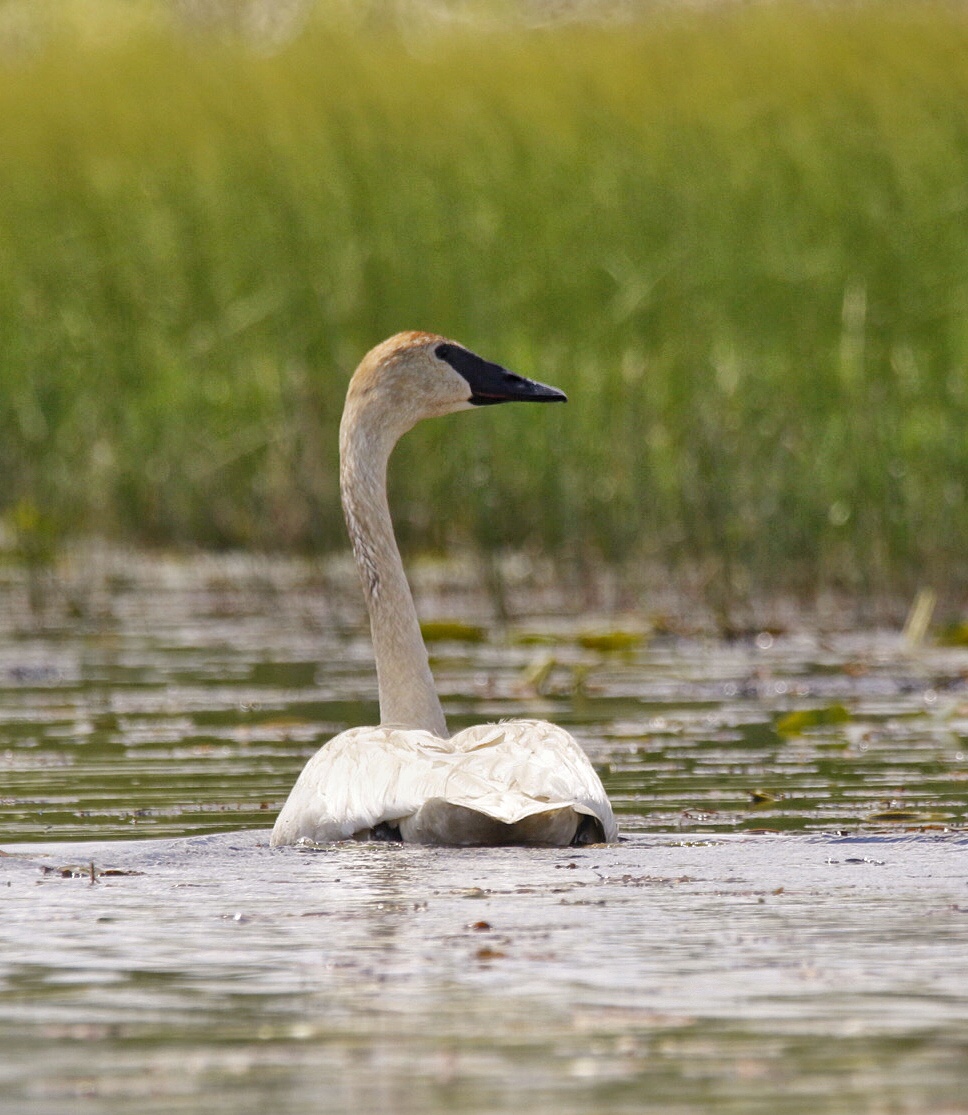
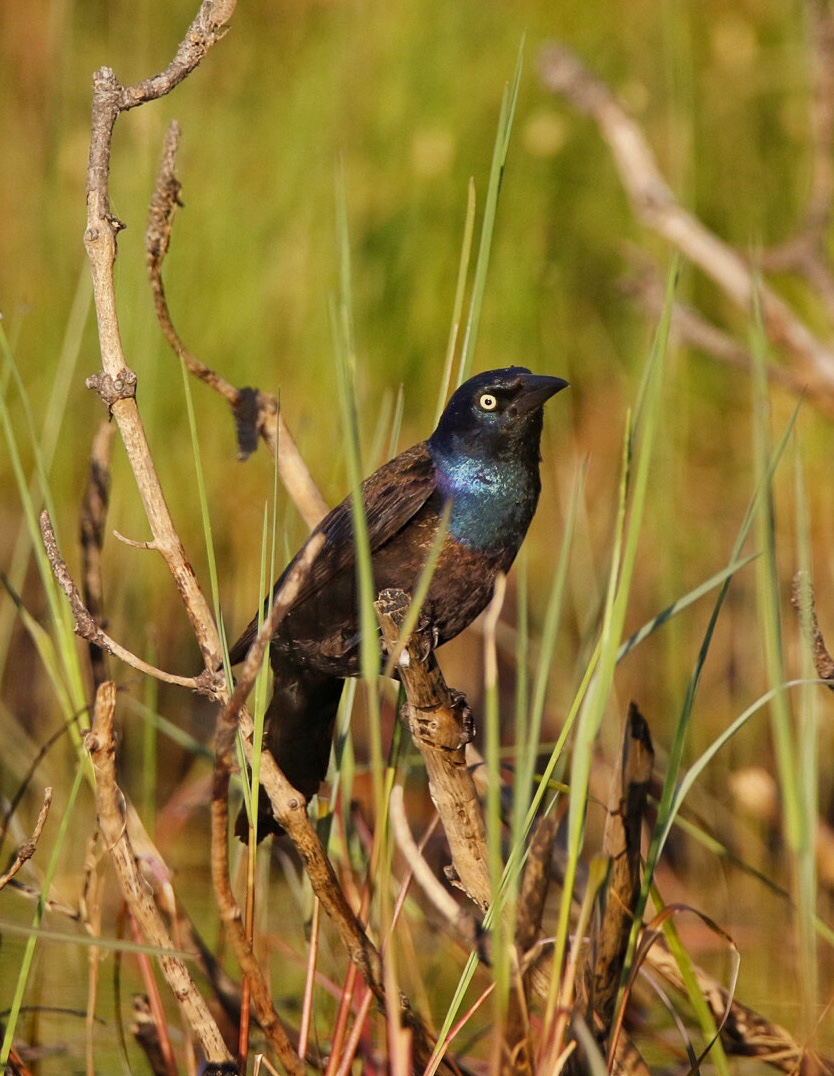
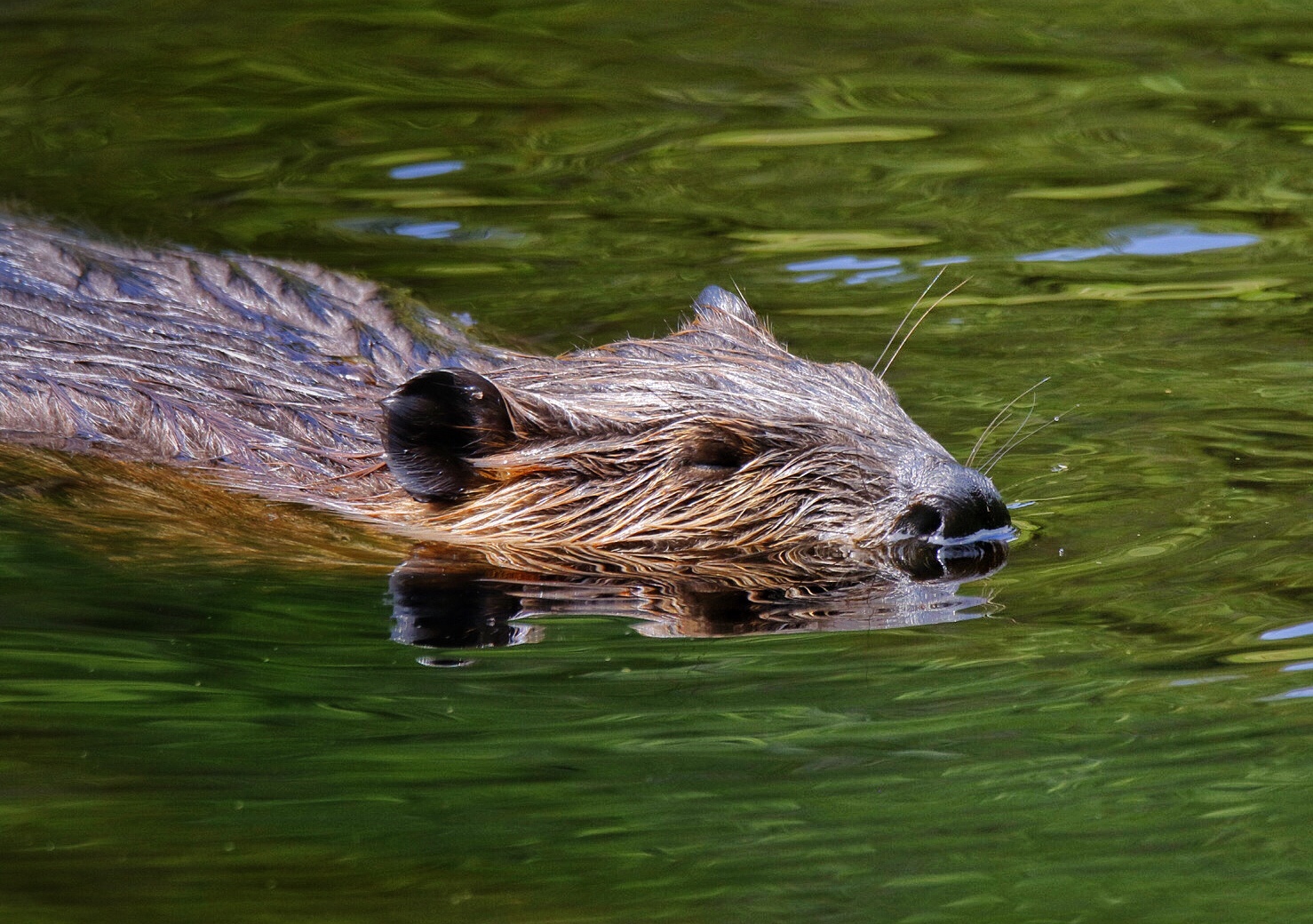

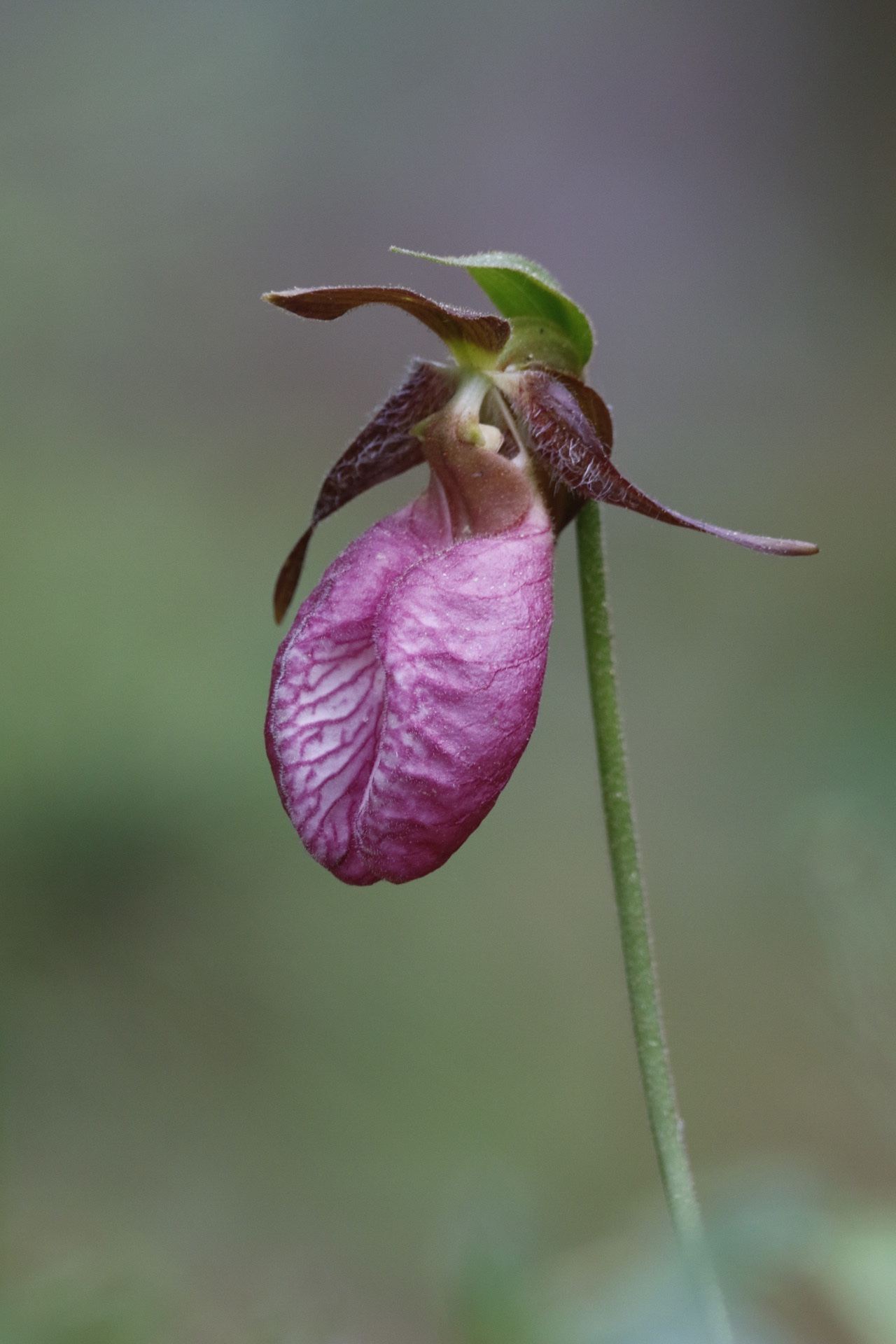
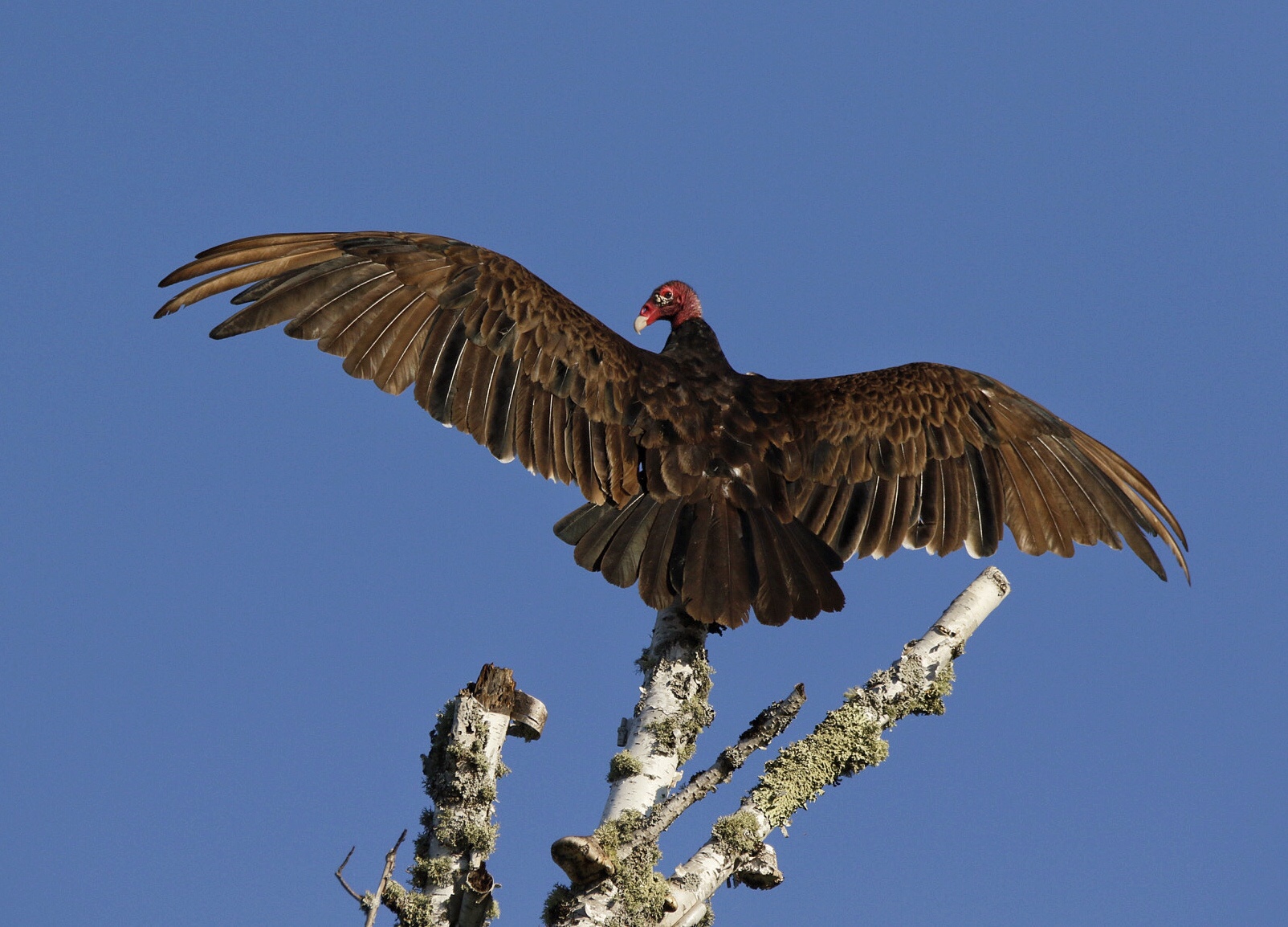
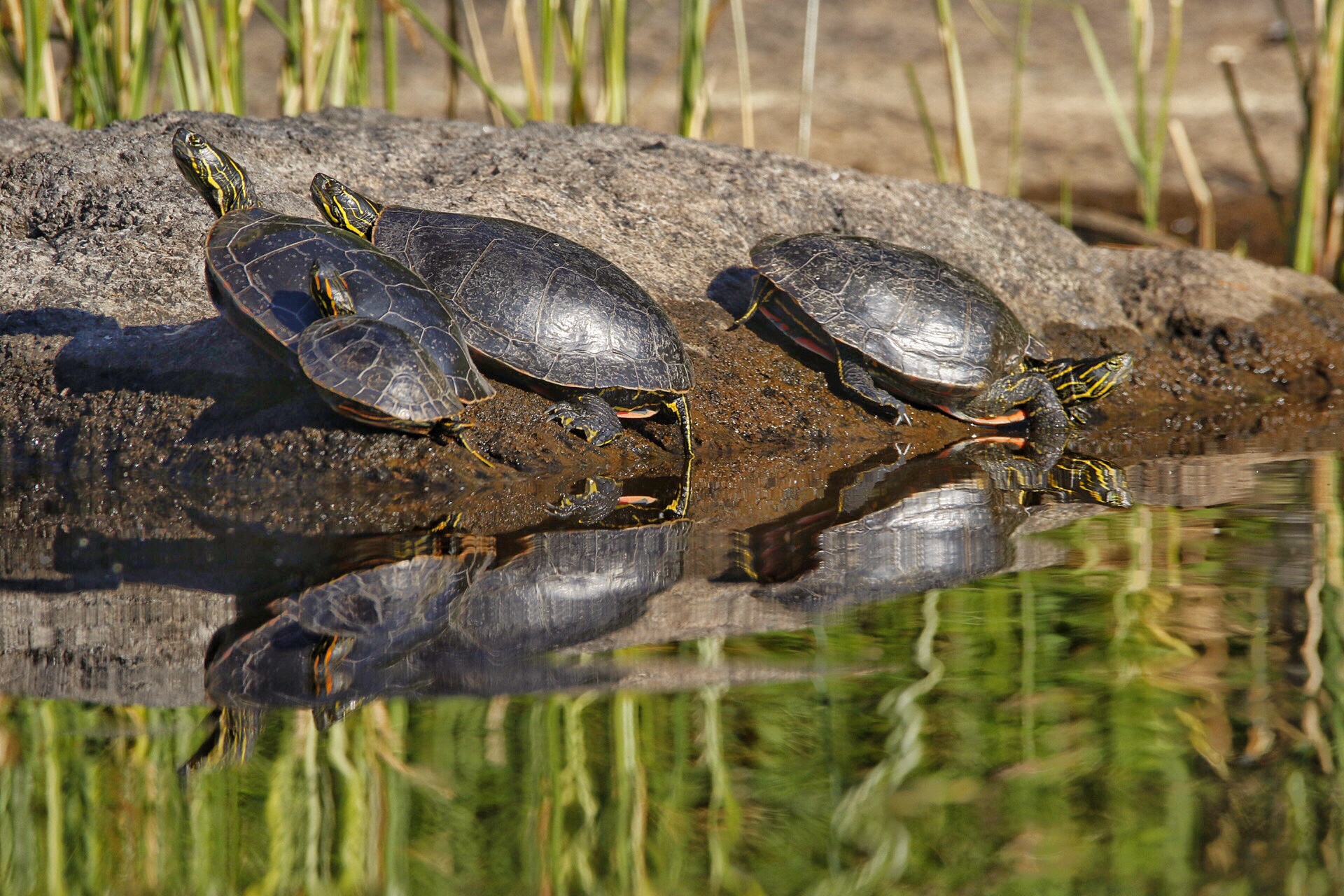
One day in a small back bay on Lake Insula we heard and then saw a Black-backed woodpecker flaking bark off a tree before he flew away. We decided to return the next day to see if could get a better look. Once again, we heard it and then followed it in the canoe around a point and discovered the nest.
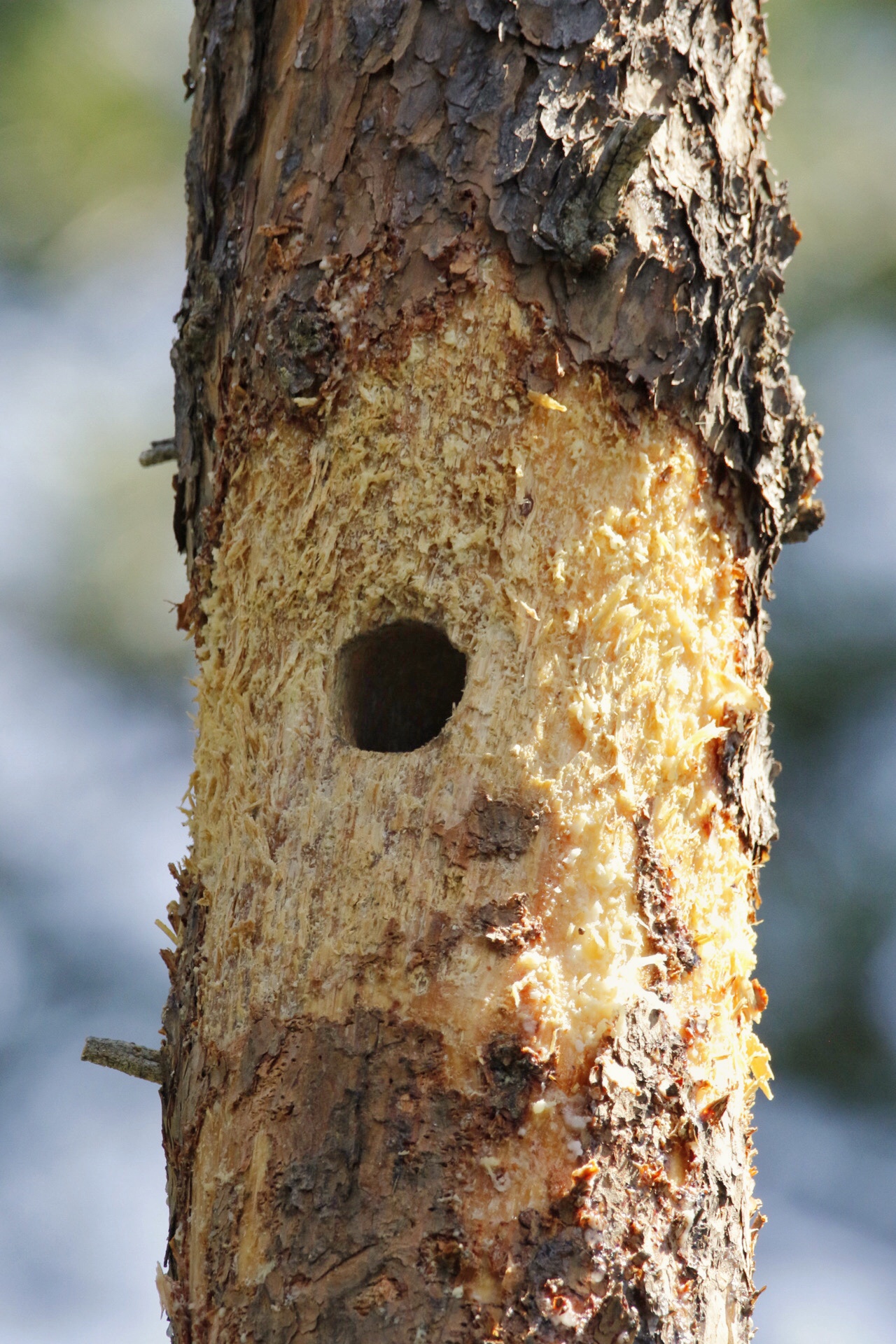
We sat in the canoe and observed the female woodpecker for over two hours as she made the rounds to the same three trees in search of bug larvae to bring back to her chicks. Each time she landed, we could hear the chicks in the nest excited for the next feeding.

We even observed her climb into the nest and fly out with a fecal sack, part of her cleaning routine. This is not a frequently-sighted bird, so once again attentiveness to our surroundings afforded us a unique opportunity.

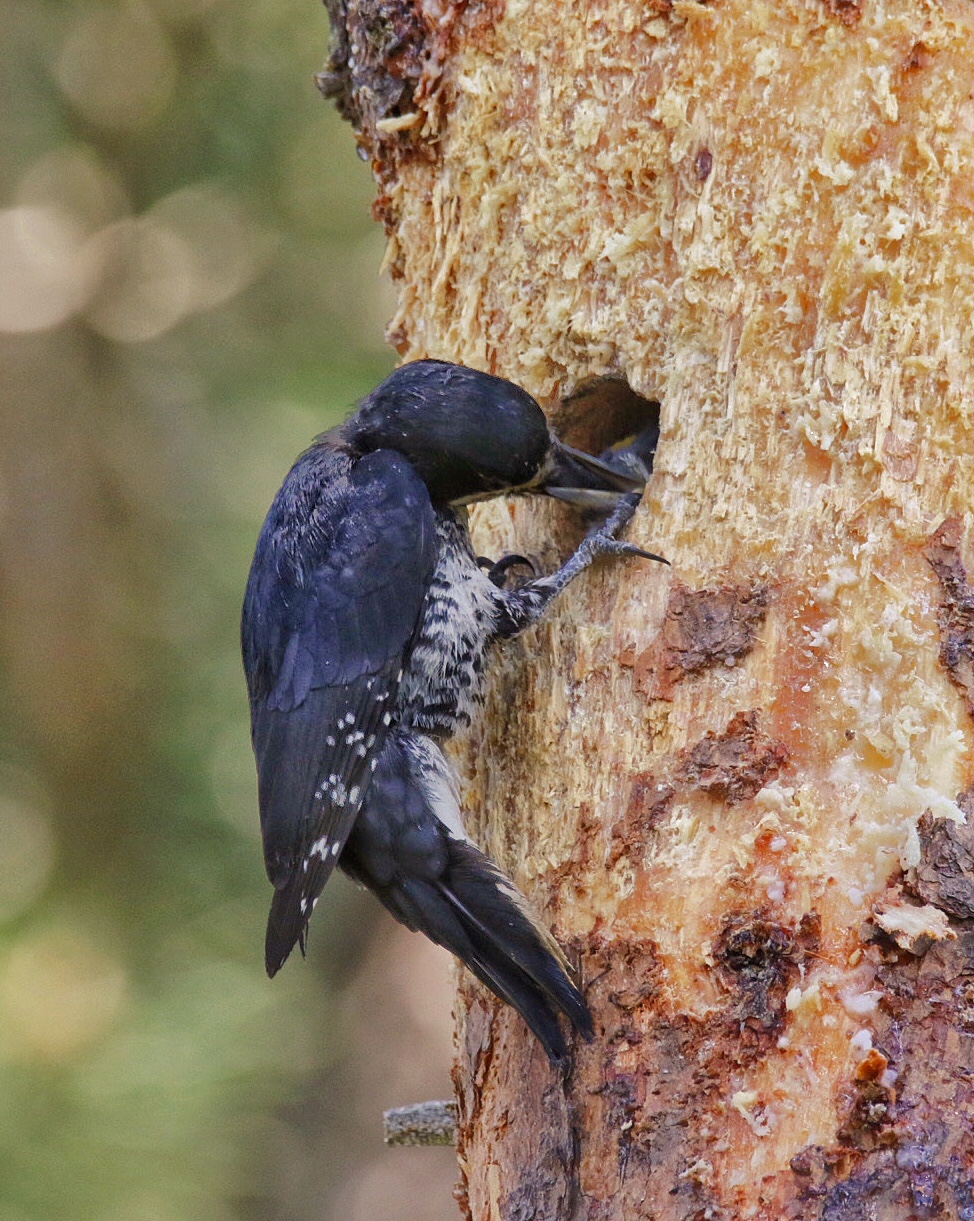
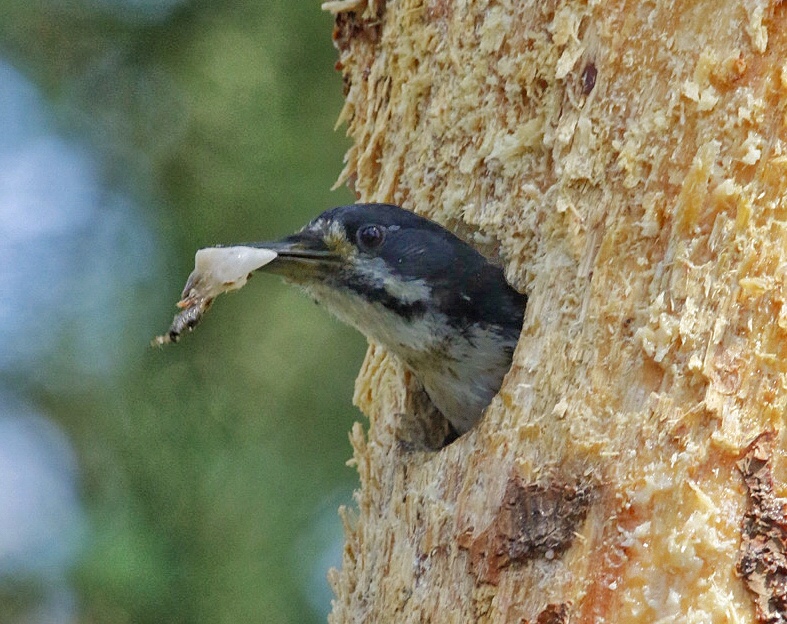
Of course, the bird we most look forward to seeing and photographing is the ubiquitous Common Loon, the veritable poster child of the Boundary Waters. We have seen and photographed them many times before, but this was the first time we were carrying DSLR cameras with a Sigma 150-600 lens, so we could get much “closer” than ever before.

The challenge with loons is photographing them in good light, on relatively calm water, with the sun lighting up their red eyes. Maneuvering in a canoe makes getting a sharp shot a real challenge. Still we were able to capture them in some of their usual behavior: diving for fish, preening, sleeping, and stretching their feet and wings.




We also found them guarding their nests. Loons do not walk well on land, so their nests are located very close to shore but are very well protected from predators.

One morning we came upon a nest and watched as one loon (it’s difficult to tell the sexes apart and both partners take time on the nest) waited to be releived from egg-sitting duty nearby in the calm water.

Several times it called for its mate and then preened and stretched while it patiently waited, always keeping a close eye on its well-hidden nest. Soon we discovered why this one was a bit nervous. An eagle had flown in and perched nearby. Lucky for us, we photographed both.
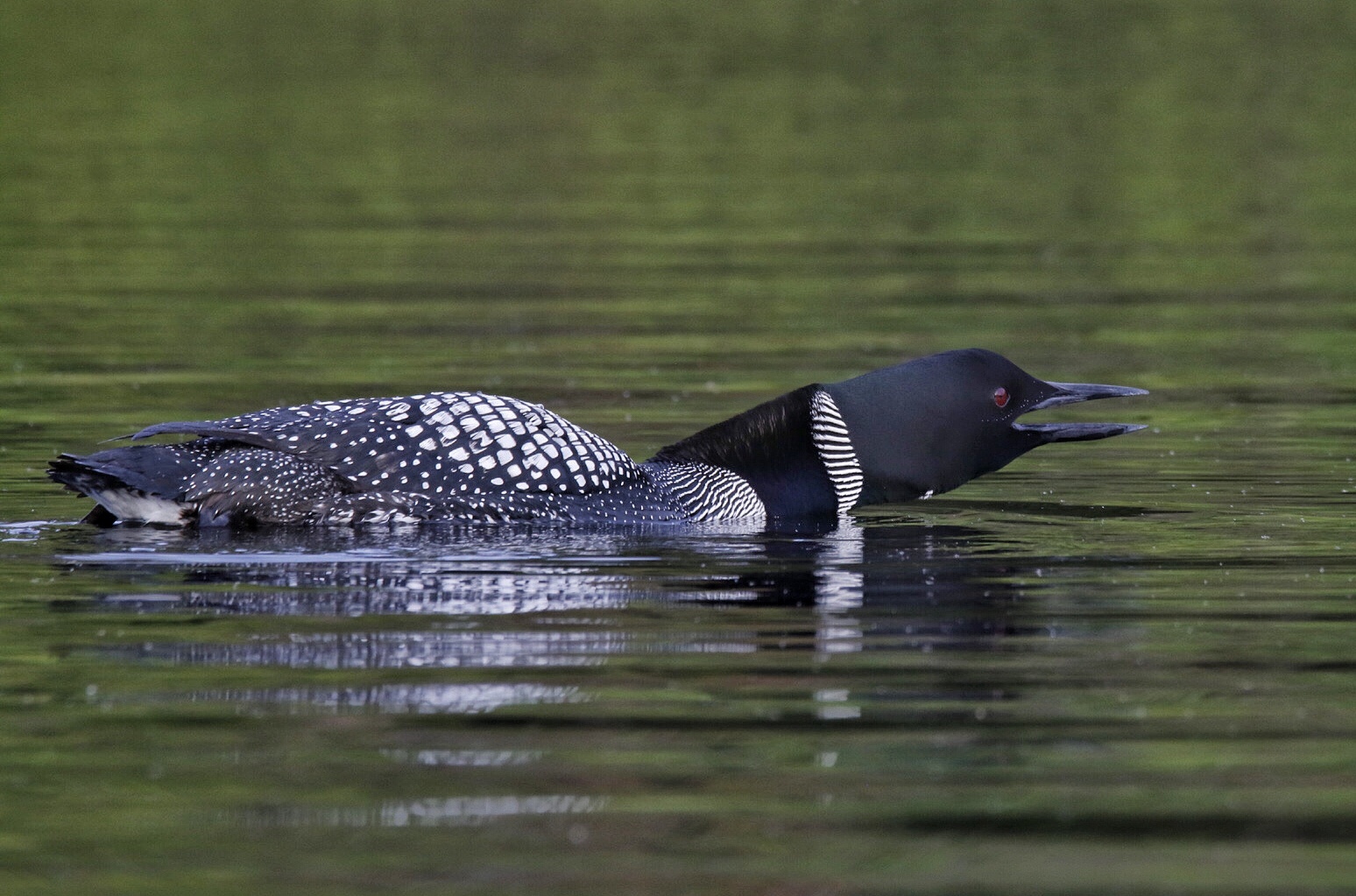

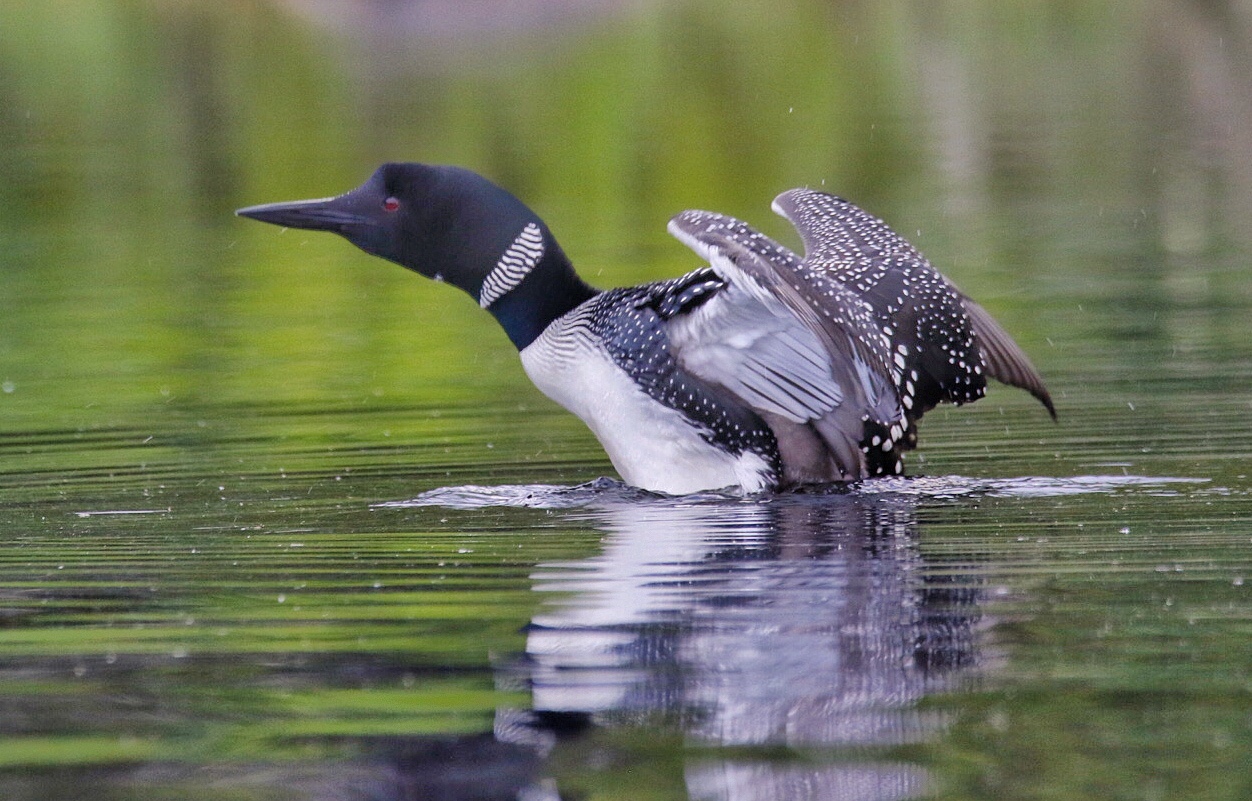


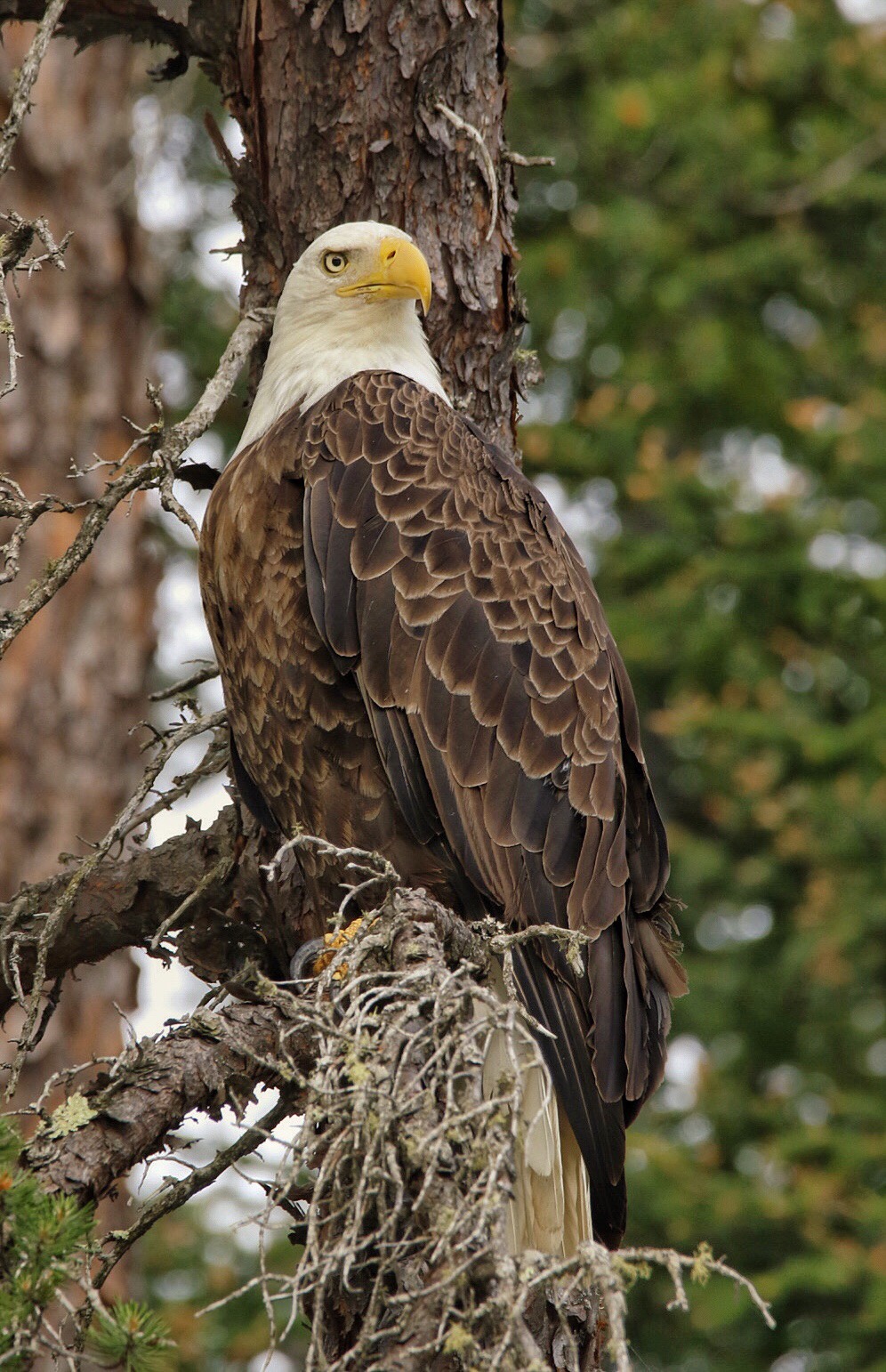
Another time, we came upon four loons cooperatively fishing together, splashing around and making a lot of noise. They seemed a little competitive with one another as well, swimming very close to one another and sizing each other up.
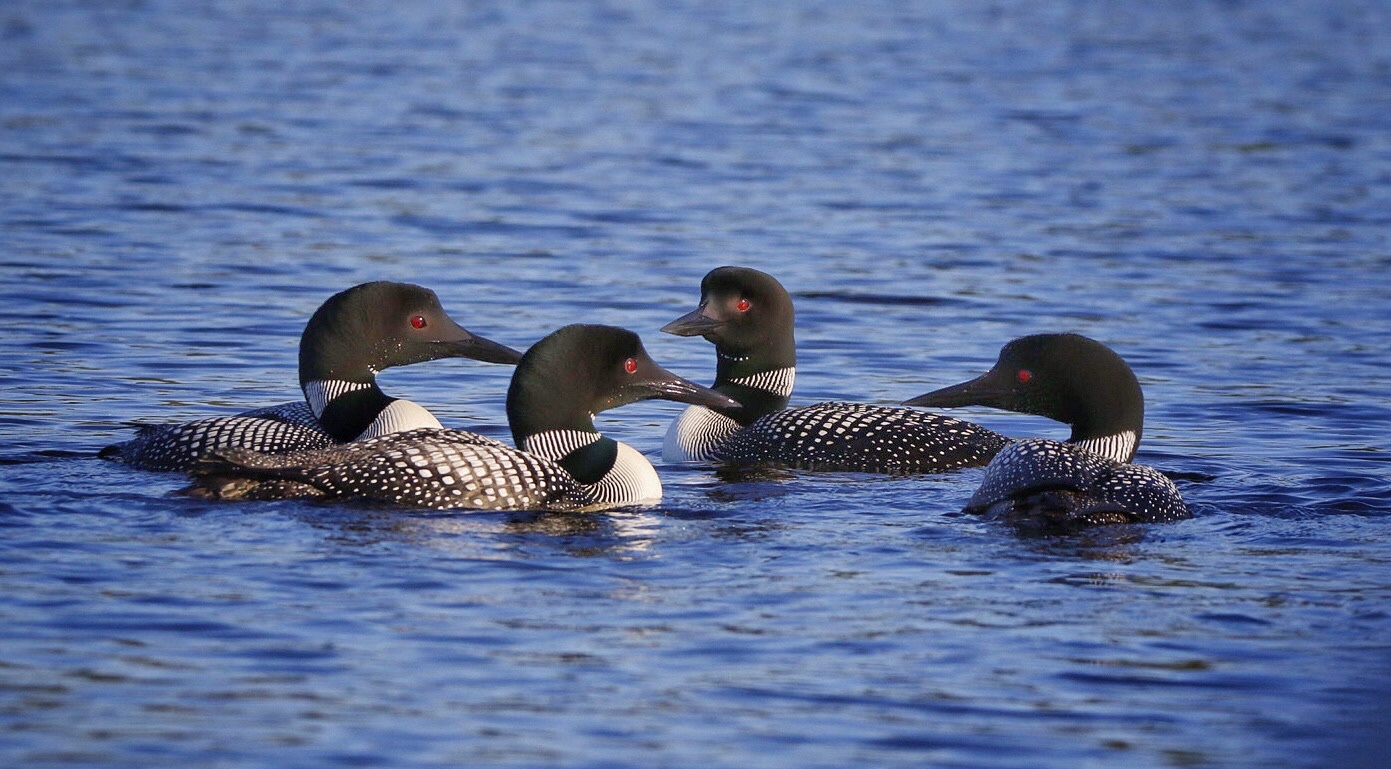
When one found a fish, the other three would dive under water at the same time, trying not to be left out of the catch.


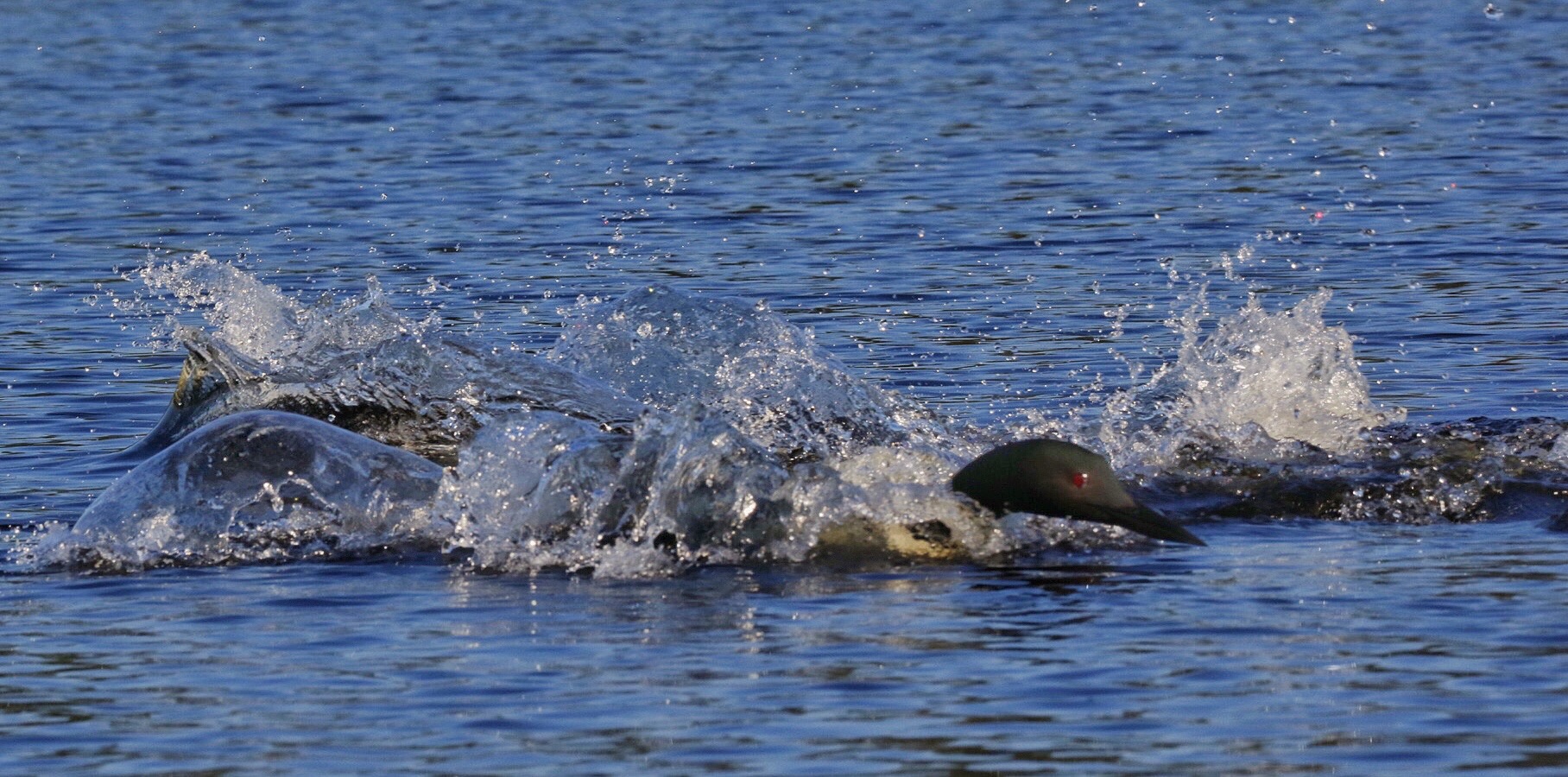

Occasionally, they would stare each other down by lowering their beak at a severe angle or posture toward one another by sticking their chest out.

Eventually, the cooperation came to an end when one loon stuck his neck out and made a strange, very loud warning call, ending the party rather abruptly.

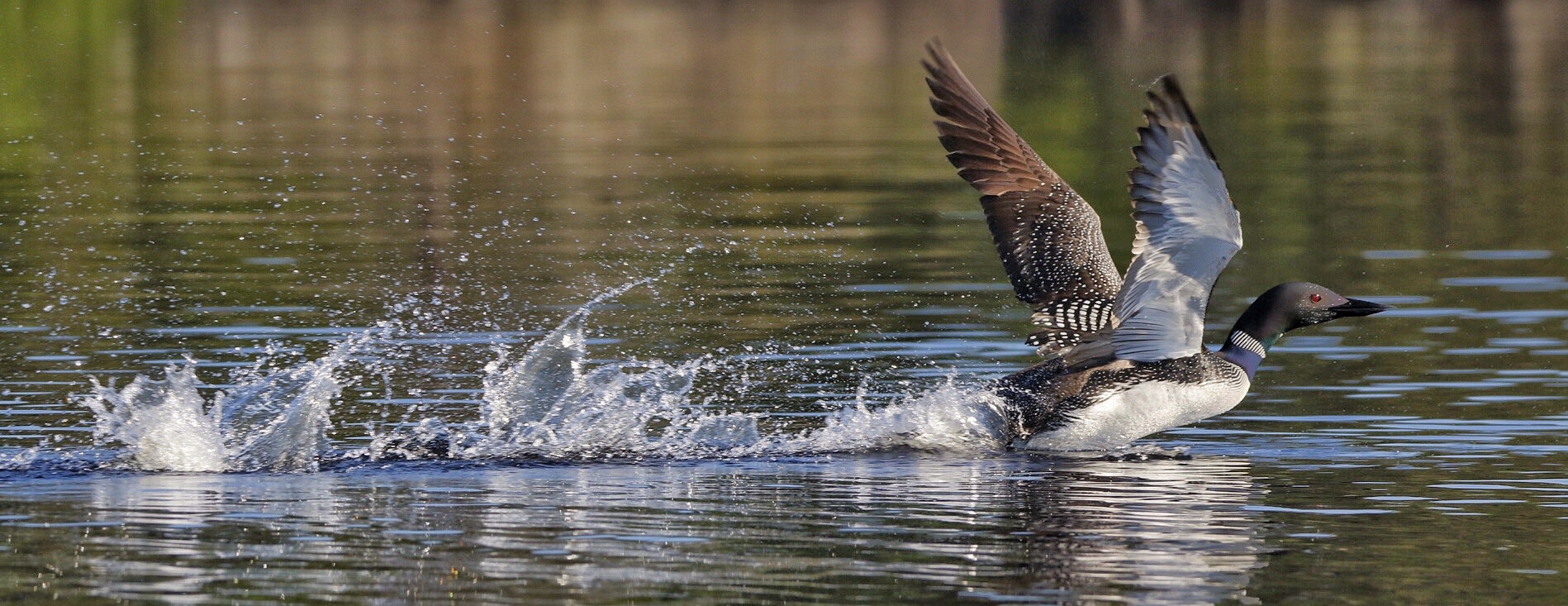
As Sigurd Olson observed about the idea of “killing time,” which he found preposterous: “I often think of the expression and how swiftly time passes in the out-of-doors where there is never a moment without something new: dawns and sunrises with mists moving out of the bays, the shifting of clouds, the way light plays with water and trees, the sound of bird calls, the sight of flowers, the movement of animals, the magic of dusk and the last slanting rays of color.”
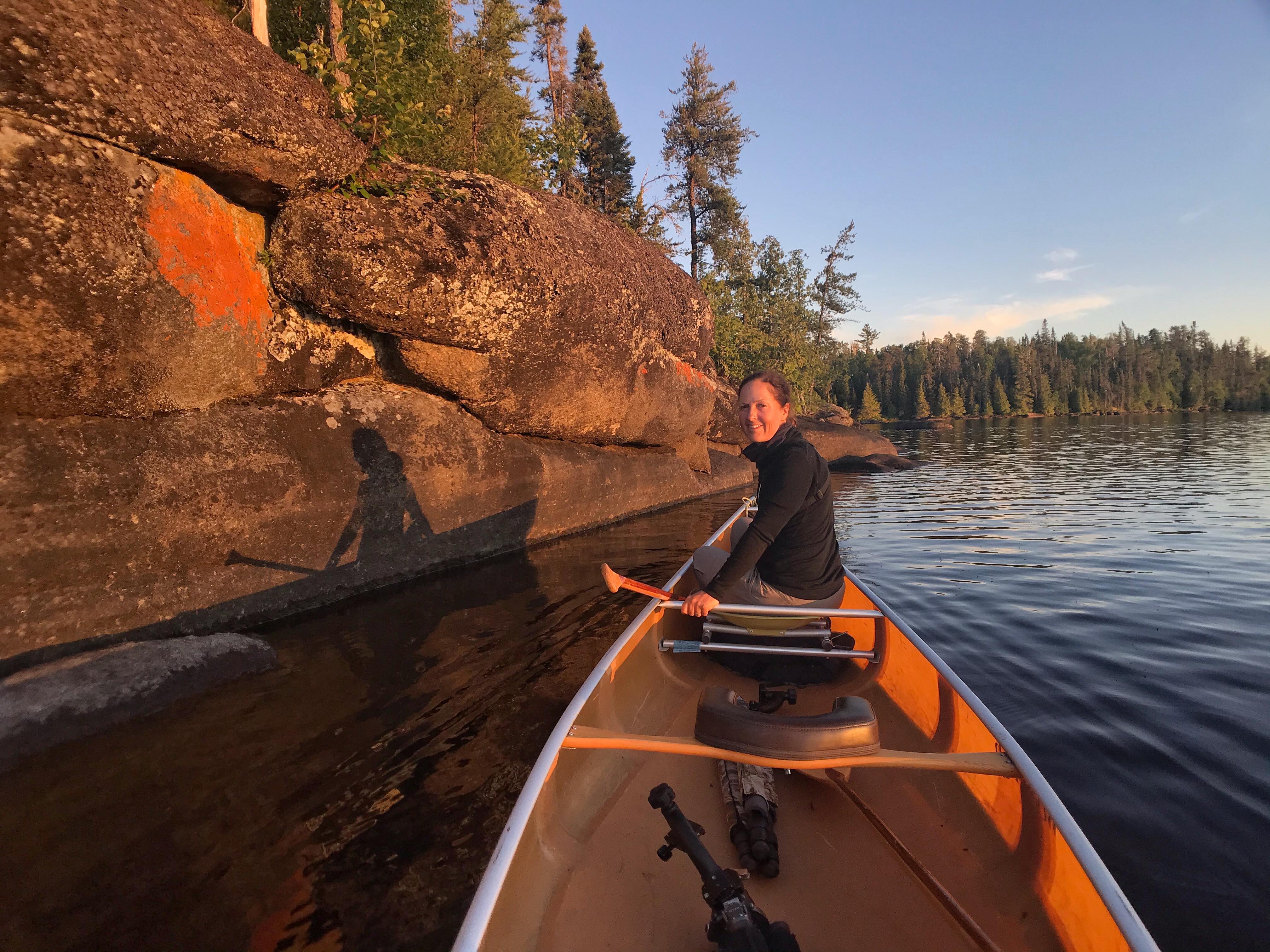

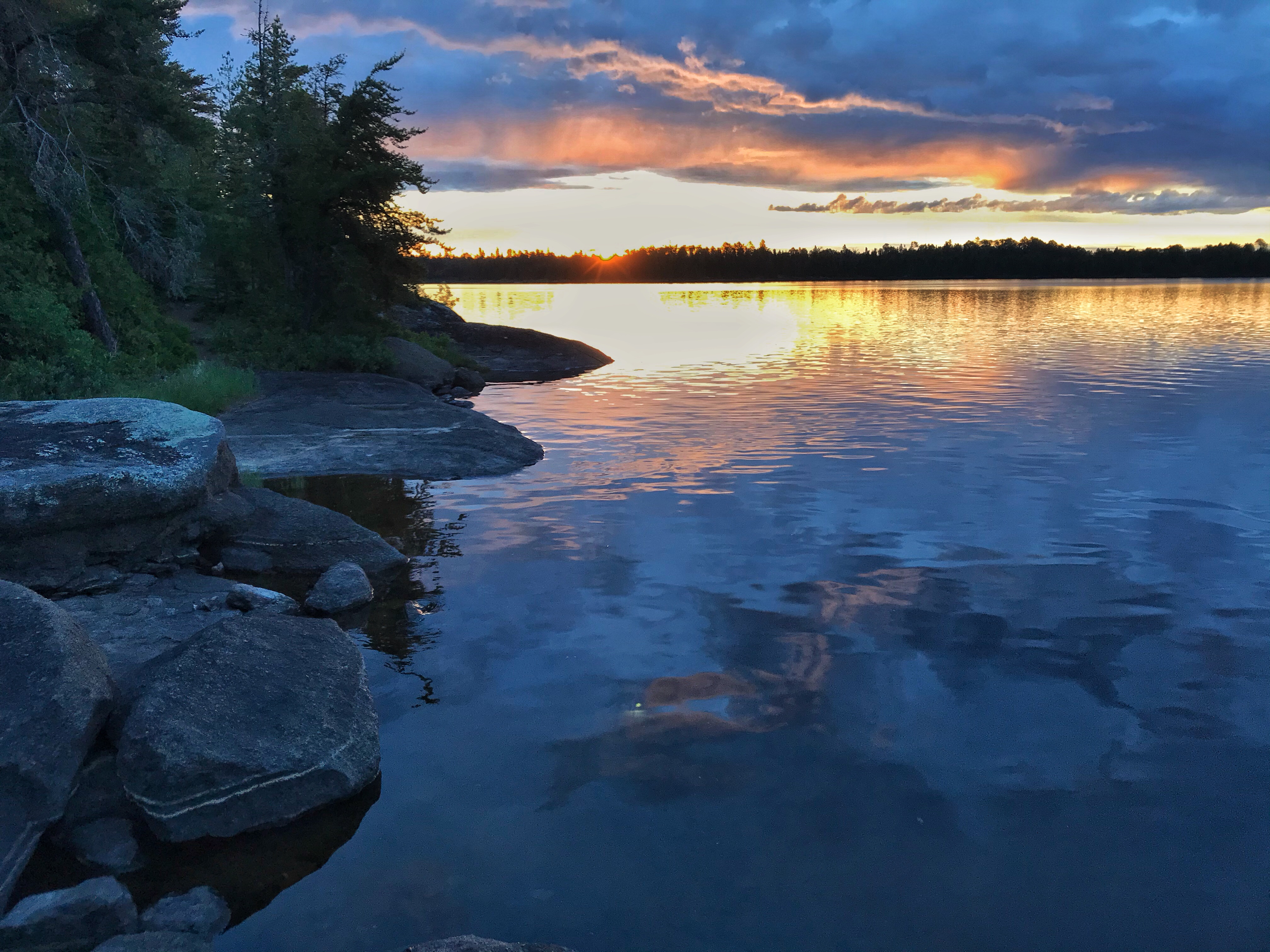

The Boundary Waters is full of surprises, and it never ceases to amaze us. No two days are ever the same. From sunrise to sunset and into the night, there’s always something to capture our imagination.

I have been looking forward to this blog coming out! And being treated to so many awesome bird pics is a bonus! Thank you! Enjoy your hike!
Thanks, Sue! The birds were a real bonus to an already amazing place. Floating turned out to be easier than hiking as you will see soon. Stay tuned for more!
Excellent photos of the Loons … one of my favorite birds. When we resided in northern IL, we used to vacation in the BWCA every summer just north of Grand Marais. We are currently spending our summer on private property near Hayward, WI and canoeing for the first time in almost 30 years. Feels fantastic to slowly paddle near a shoreline taking in the scenery.
I recently read that the Loon population is in trouble due to the flourishing population of Eagles.
Hi Ingrid, thanks for your comments. Since this post we actually took a third trip back into the BWCA, but this time off the Gunflint entering on Poplar Lake, so stay tuned for a little more. We saw, firsthand, evidence off the loon vs eagle standoff. I’m sorry to hear the numbers are down, though. You’re probably familiar as a BWCA canoeist, but if you’ve not read Sigurd Olson’s “Singing Wilderness,” we highly recommend it. No one speaks of the joy of canoeing more poetically!
They are baaaaack! This was a godsend this morning as I sipped coffee on my patio, listening to the wrens and robins, pretending I was there.. I will, yet again, live vicariously through your exploits. Merci beaucoups! And….may safe travels continue.
Thanks, and glad to be back. I hope we continue to inspire your mornings!
Thanks for your wonderful blog. The photos and expressions of your thoughts and observations provide a most welcome respite from the otherwise depressing reporting of the continuing news that we see and hear in the papers, on TV and on our phones.
Keep up the great communications, stay well and enjoy the rest of your adventure.
Thanks, Frank. We always appreciate your support. And yes, it’s been a good and necessary break from our current reality. A helpful reminder to all to take a pause and find joy wherever you can.
Fantastic images! Inspiring, makes me consider cheating on my kayak and go canoeing. Amazing waters.
Thanks, Goran. I think you can safely go canoeing without cheating on your kayak. In fact, we see more and more kayakers in the Boundary Waters, but it’s really more suited to a canoe if you are going for multiple days. Give it a try!
What a lovely post with stunning photos!
Amazing place too! Thanks for sharing
Thanks! Would love to come see your mountains some day, too.
HAPPY BIRTHDAY, Alison
Love,
Dad.
Great job on the bird photos!
Always a challenge but so rewarding when you get one!
First of all, belated HAPPY ANNIVERSARY! @) 20 years. So happy for you both. Thank you so much for sharing your narration and FABULOUS pictures (That new camera was worth every dime you paid for it). The colors and clarity in your pictures were breathtaking. I so enjoyed reading and observing with you.Thank you, thank you! How smart you were to escape Covid for a wonderful trip to the Boundary Waters! I’m sure it helped put normal back into your lives Enjoy!!!.
Thanks, Rick. Canoeing turned out to be a great way to celebrate 20 years. Since we spent our honeymoon camping our way up to Alaska and back, this felt like we were coming full circle. Be well, friend!
My Dear Alison and Matt,
Your descriptive photos and written comments have been missed.
Your blogs have always been an escape for me as I imagine to be with you.
Boundary Waters will be one of my favorites of your adventures because of how you captured and examined the beautiful simplicity of nature. You were so patient in ‘catching’ the perfect moments.
I actually had watery eyes as I viewed each photo one after the other. I really needed this gift of nature since January 31st was my last trip outdoors. Thank you for that.
Was thinking about you on Wednesday, your birthday, Alison. Hope you enjoyed your day.
God bless you both. With love, kp
Hi KP!
So nice to hear from you! We are so pleased that our adventures provide you some joy and escape to nature during these trying times. It’s been hard for everyone to remain sheltered for so long. It makes you really appreciate the ability to just step outside, look at a flower or breathe fresh air. Thank you so much for the birthday wishes. Hang in there and hope to see you soon.
Beautiful photos. Very nice Blog.
Thank you very much, Sri! We really appreciate you following along. Thanks for checking us out!
Nice to see you two again! Lovely photos. I hope you get dry weather soon!
Thanks, Joann! It was nice to be able to focus on the photography so much on this trip into the BWCWA. Thank you for following along with us!
As always, you inspire me M&A. And simply gorgeous photos. The first, fifth and sixth are three of the most stunning I’ve ever seen of the BW.
Thanks, Jay! That’s quite a compliment! Photography by canoe can sometimes can be a little challenging, but it always pays to get up early and stay late for the light. 🙂 Cheers!